63 Chinese Cuisines: the Complete Guide
Not one cuisine, not eight, but many more. Our best shot at a comprehensive-ish guide.
One country, one cuisine.
It’s a model of food that really underpins how people tend to think about, organize, and categorize food. Search Google Maps, and your local eateries are bound to be arranged into “Thai” or “Italian”. Hop over to Taste Atlas, and you’ll find little country flags next to each article. On Reddit’s /r/cooking, it’s practically a semi-annual tradition to see someone attempting to make ‘food around the world’, dutifully hopping around the globe nation-state by nation-state. When Good Mythical Morning guesses where a certain dish is around the world, they throw a dart at a map divided into… countries. These divisions can even turn into a political project: food slotting in right there next to the national anthem and the flag emoji.
And in fairness, it’s certainly not complete bullshit. Borders set trading networks, so they often set what ingredients are available. Borders (often) set a language, so they set the linguistic pathways of how recipes spread.
But at the same time, it’s… kind of bullshit, right? Like, people in New York eat much more similarly to people in Toronto (or maybe even Sydney!) than they do to people in New Orleans. Geography matters. Culture matters. And these things quite often don’t neatly align to the various colors on the map.
And it’s in China, perhaps, where the one country, one cuisine model goes to die most violently. Sit Cantonese food next to Sichuan food, and the absurdity becomes aggressively spectacular:


And so, if you satiate your curiosity with a quick Google, you’ll often find people saying that “China doesn’t have one cuisine, but eight”.
“The Big Eight”
We could maybe even turn it into a little jingle.
“Cantonese, Sichuan, Hunan, Jiangsu, Zhejiang, Fujian, Shandong, and Anhui.”
The ‘eight cuisines of China’ — it’s a fun little bit of food trivia. I feel like when you’re new to the sport of Chinese food, it’s a fresh new model that can easily graft in and replace that tired, old one country, one system framework.
There’s other resources online that go into detail about The Big Eight. Personally, I don’t really want to dwell on the thing — after all, even if you’re fresh to a sport, I’m not a big believer in starting with bad form.
As you might be able to gather, I’m not exactly the most massive fan of the trope. I mean, the food’s good, of course. But there’s… a couple of issues:
The most obvious, glaring problem is the incompleteness. Take, for example, one of the most famous Chinese restaurants in America: Xi’an Famous Foods. The Anthony Bourdain favorite, the Millennial Hipster darling. People fell in love with their Roujiamo (“lamb burgers”); their slippery liangpi became a New York food sensation. They put Biang Biang noodles on the American food world map.
So where is Xi’an on this map?
Oh.
Like… the map’s overlooking not just Guizhou and Guangxi, it’s overlooking literally the entire North of the country. No Lanzhou Hand-pulled noodles, no Peking Duck.
What’s going on here?
The missing context, I think, is that ‘The Big Eight’ was never meant to be an exhaustive list of all the cuisines of the country. It was a somewhat haphazard extension of the so-called “Big Four” banquet traditions of imperial China: Cantonese (粤), Sichuan (川), Shandong (鲁), and Jiangsu (苏). The reason why The Big Eight contains Cantonese and not Yunnan isn’t because people in Yunnan don’t have a unique cuisine — it’s because Cantonese had an establish system of banquet presentation that was enjoyed by the merchants and the Mandarins of the Qing dynasty, and Yunnan didn’t.
This cultural background is sort of… implicit knowledge for a lot of foodies in China — implicit knowledge that I don’t usually see translated into English. So, there you have it.
But at the same time? I don’t think it’s exactly fair to tear down The Big Eight without building something to replace it. After all, it’s still a better starting point than One Country, One Cuisine! It’s just incomplete.
But then… if not eight, how many cuisines are there?
I’ve never seen anyone attempt to count.
So, we attempted to count.
The 63 Cuisines of Mainland China
Welcome to the project that drove me to the edge of my sanity.
Here’s our map:
Here’s a full(er) res copy. Save it, peruse it, share it, whatever.
This post is… a little bit of a knowledge dump. I hope it can be a resource. It’s definitely gunna be too long for email, and probably too long to read in a single sitting. Think of this as the coffee table book of the Chinese Cooking Demystified Substack — it’s here to open, browse, and poke around from time to time.
Further, I also want to emphasize that we tried to come to this project from a position of humility. How to define the boundary of a ‘cuisine’ is not obvious. I went into (probably overly excruciating) detail about our methodology in the accompanying video, so I won’t re-hash too much of it here. Our rules of thumb were:
Passing The 50% Rule. If you’d estimate that more that 50% of the dishes are ‘unique’, and the dishes that remain often have different versions, it’s a separate cuisine.
Culinary Self-Determination. Do the people themselves (particularly the food world) make a distinction between cuisines? E.g. people in Louisiana are quick to make a distinction between Cajun food and Creole food, so to us this would be two distinct cuisines - even if the differences may not be overly obvious to an outsider.
Failing the ‘Mutual Intelligibility’ test. Imagine an old, talented home cook from one area. Would they be able to recreate a dish from another area solely from taste, without looking anything up?
‘Culinary Continuums’ must be broken somewhere. A little like dialect continuums in linguistics, there can often be small changes in food between neighboring towns and cities - that then morph into large differences if you zoom out and look at either end of the continuum. Boundaries will ultimately arbitrary.
There will likely be a lot of contention about some of these boundaries, and there’s absolutely stuff that we missed. We’re also personally the most familiar with the South of China, so differing opinions and viewpoints are more than welcome.
All we wanted to do was improve on the big eight.
Note: Taiwan is included in the below maps because the lowland regions have been part of the China proper social-ecological system since the 1600s. As we discuss in our section on Taiwan ‘outside of mainland China’, this was then layered with other provincial Chinese cuisines as KMT forces fled to the island. It implies nothing about the political status of Taiwan.
(we also don’t get in any trouble this way)
Guangdong Province


We divided Guangdong into six cuisines (nine if you include Macau and Hong Kong).
Cantonese is, of course, by far the most well known of the six and needs little introduction.
And yet, at the same time, I think the cuisine can sometimes be a bit misunderstood. If you ask ten Cantonese chefs what the ‘essence’ of Cantonese cuisine is, practically to the man they’ll reply ‘keeping the original flavor’. It’s a motto that works pretty well within a Cantonese cultural context: as a way to proudly distinguish yourself from the Sichuan and the Hunan. Less realized, I think, is that in an international 21st century context, the trope communicates as a self-own more than anything — a bit like bragging about how wide your city’s downtown freeway is: “okay, got it, Cantonese food is a stuffy old cuisine that doesn’t know how to season things”.
And while it’s certainly true that Cantonese food opts not to impress with chili peppers by the fistful, this isn’t exactly Scandinavian hospital food either. Black fermented soybeans feature prominently, ditto with other fermented sauces. The use of dried seafood and mushrooms — practically umami concentrates — is ubiquitous. Hell, on an international scale, they might even be less afraid of the chili pepper than their reputation might suggest…
Instead, to me, Cantonese cuisine is all about The Democratization of the Haute. In the age of Imperial China, there was a sort of ‘national cuisine’ of the elite called Guanfu cuisine, which we’ll touch more on in our discussion on Beijing. During the 19th century, the merchant class in Canton grew in breadth and depth, and the food they ate ended up borrowing quite a bit philosophically from that Guanfu tradition.
And what was that tradition all about? Well, outside of simply showing off (the food of the elite forever rhymes), that cuisine particularly loved the playful manipulation of form.
To illustrate, the Cantonese Pearl River is the land of two fish - the lingyu (Dace) and the wanyu (Asian Carp). And so, yes, they do sometimes opt to keep that ‘original flavor’ to make sashimi — and Shunde-style Sashimi is quite delicious. But you can also chop some fish up real fine and use it as a stuffing (e.g. for chilis). Or you can take that paste, mix it with egg white, deep fry it and get a dead wringer for tofu. Or you could pan-fry that fish, shred it, and toss it in a water chestnut starch-thickened soup and make a ‘congee without rice’.
You see this sort of thing again and again in Cantonese food — it’s a fun cuisine. I mean, on some level isn’t the entire Dim Sum cart “stuff stuffed in stuff, stuffed inside of other stuff”? What makes Cantonese food awesome is that every time you’re lounging al fresco at a Daipaidong, every time you’re grabbing steamer baskets from the Dim Sum house… you’re eating an echo of the Qing Dynasty elite. And that, I think, is a beautiful thing.

Of course, geographically speaking, this cuisine — together with Cantonese language and culture writ large — is quite bound to the Pearl River system. It starts from the delta smack dab in the middle of the province and continues westward. You can find Cantonese speakers all the way into the Guangxi province next to the Vietnam border, but hop one or two peninsula to the east of the Pearl River Delta and you’re already starting to get into a very different linguistic and culinary zone.
To the east, there are two primary cuisines: Teochew and Hakka. Teochew (Chaozhou, in Mandarin) may appear similar to Cantonese at first blush — neither cuisine features the chili pepper very prominently — but any apparent similarities are quite surface level. There’s not much crossover in dishes, and what dishes they do share often have different versions. Cantonese meals are based around white rice; Teochew meals can be served with rice or they can equally be served with mue (糜), a thin rice porridge often paired with salty preserves. Teochew language is mutually unintelligible with Cantonese and more closely resembles the Min languages next door in the Fujian province.
With that said, Teochew and Cantonese have obviously had more than a little bit of contact over the centuries. Besides being not all that far apart, both cities were famed for their (rival) merchant classes. Both groups helped build the twin economic engines of Hong Kong (a bit more Cantonese than Teochew) and Shenzhen (a bit more Teochew than Cantonese). This is why Hong Kong fishballs are generally the Teochew style, and why you can find Teochew-style Cheong Fun variants on the streets of Chaozhou and Shenzhen.
Hakka, meanwhile, are a fascinating Chinese subgroup thought to have migrated over the centuries from the north of the country down into the south. Precisely why that was is hotly debated, but by the late Qing they nonetheless ended up settling down in the mountainous bits of Jiangxi, Fujian, and Guangdong. As migrants, they were often confined to land that was less productive agriculturally, and the sweet potato formed the foundation of the traditional Hakka diet. Historically, there was no love lost between Hakka and Cantonese - there were even wars fought over land in the mid 19th century.
These days however, that history is a distant memory. But Hakka food still bears some imprint of it - while rice is the modern staple, sweet potato features much more heavily than in Teochew and Cantonese. And - apocryphally, at least - a number of classic Hakka dishes are thought to have been forged from attempting to make wheat-flour based northern Chinese foods in a new land that didn’t really have much wheat (e.g. their stuffed tofu is said to be a dumpling equivalent, though I think it’d be fair to register that claim as… ‘debatable’).
Dong River Hakka, meanwhile, consist of Hakka communities in Huizhou, Dapeng (Shenzhen), and other bits scattered around the Pearl River Delta1. This is one of those ‘culinary self determination’ internal divisions, as Dong River Hakka is generally considered a distinct by many Hakka chefs. A reasonable argument could be made that the food in this area is really more of a cross between Hakka and Cantonese than a distinct cuisine per se, but admittedly we haven’t spent much time in the epicenter of Huizhou.
Returning back to the Pearl River system, as Cantonese moves to the west and into the hills, the food begins to change. Flavors become stronger, you start to see some echoes of non-Han influence (e.g. steaming in bamboo), and fermented ingredients start to appear more often than the Cantonese mainstay of dried ingredients. We drew the line between Cantonese proper and its more strongly flavored cousin (“Xi River” cuisine) at the province border, but a little east or west would also make sense. In the hills, we also chose to separate Lianzhou - an area with a good chunk of Yao people influence - out as a distinct cuisine.
The Coastal west of Guangdong shares a number of similarities with Cantonese, and could perhaps be lumped in with Cantonese if you were feeling lumpy. That said, the south of Guangxi along the gulf of Tonkin (Beihai), the lowlands of Hainan (Haikou), and the Leizhou peninsula in Guangdong (Zhanjiang) bear some striking similarities - this region sometimes being referred to as ‘Qin-Lian-Lei-Qiong’ (钦廉雷琼). The prominence of seafood would probably be the most obvious element of the cuisine to a traveler, but things are also starting to get a bit more heavily seasoned, ala the food in neighboring Guangxi. Their mixed rice dishes are also renowned - most famously the Haikou area’s chicken rice, which over the years became a favorite throughout Southeast Asia as well. Also interspersed in this area are also communities of Teochew speakers (lost on their way to Southeast Asia, perhaps?), which also influenced the food in a number of ways, most obviously with various rice products called he (籺).
Cantonese





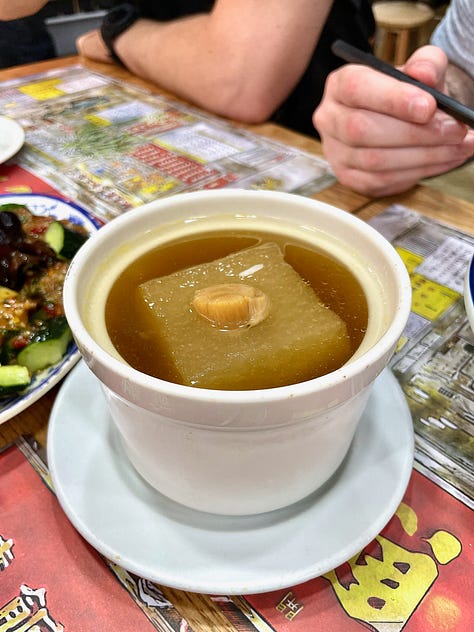
Representative dishes:
Wonton Mee (云吞面). Top left. Wonton noodles, a Cantonese classic. Often served in soup, this version was ordered dry with soup on the side - smothered with dried shrimp roe, and oyster sauce to mix.
Dim Sum (早茶). Top middle. This particular dish is Siu Mai (烧麦), a pork and shrimp dumpling.
Cheong Fun (肠粉). Top right. Breakfast rice noodle rolls, topped with a seasoned soy sauce. There can be various stuffings, but are often rather subdued - this specific one is a bit of pork mince. Soy milk is a more common drink to go along with it, but if you’ve got a nice coffeeshop next door, why not?
Claypot Rice (煲仔饭). Bottom left. Much beloved Cantonese dish, complete with crispy rice (i.e. socarrat) at the very bottom. This one was topped with pork ribs and Cantonese sausage.
Char Siu Rice Bowl (叉烧饭). Bottom middle. Cantonese roast meats are iconic - from Siu Yuk Pork Belly, to Roast Goose, to Roast Duck. This is Char Siu BBQ pork, served with egg in a rice bowl and topped with seasoned soy sauce.
Double Boiled Soups (炖品). Bottom right. Cantonese cuisine is quite renowned for their tradition of soup making - this soup in particular is scallop with hairy gourd (瑶柱炖节瓜).
Teochew
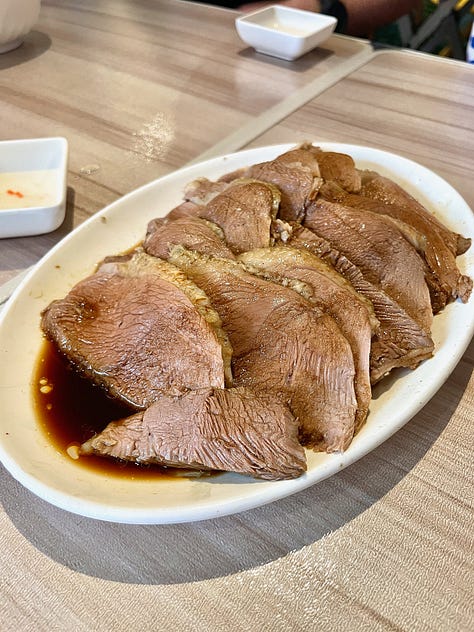





Representative dishes:
Teochew Lushui (潮州卤水). Top left. Teochew Lushui (master stock) has a unique spice mix - including additions like lemongrass and galangal. Stewed goose is a very classic item (卤鹅) and the “lion-head goose” (狮头鹅) is particularly prized. This one is a plate of goose breast.
Mue (糜). Top middle. Pictured is a simple bowl of mue with its classic pickled pairings. The preserves that goes with Teochew mue congee are called giamzap (咸杂), meaning “various salty things”. Pickled daikon (菜脯) is the most classic.
Chinese Black Olive with preserved vegetable (橄榄菜). Top right. The most famous giamzap outside of the region is Chinese Black Olive. Pictured is a bottle of pickled mustard green with Chinese black olive (which, I have to say, is also fucking incredible topped over white rice as well).
Oyster pancake (蚝烙). Bottom right. The coastal southeast - from Chaozhou to Fujian - has a tradition of using sweet potato starch to make various kinds of pancakes, of which oyster pancake is probably the most famous. The most common variant in Chaozhou is (1) a round pancake with (2) eggs added and (3) fried until the edges are crispy.
Seafood congee restaurants. Bottom middle. Being a rocky coastal area, historically the region didn’t have much land for rice cultivation, leaning instead on the ocean. Pictured is a local congee restaurant in Jieyang city with fish and seafood laid out front. Choose your seafood, the kitchen whips it up, and you enjoy it next to some mue congee.
Guorou (裹肉). Bottom right. Common to the area are various forms of ‘rolls’ containing meat or seafood, rolled up in thin tofu sheets then steamed to form. This one in particular is a type of roll called guorou in Mandarin (裹肉, lit. ‘wrapped meat’) - cut into pieces, deep fried, and served with a sweet fruit sauce.
Hakka






Representative dishes:
Stuffed Tofu (in soup) (酿豆腐). Top left. Hakka cuisine loves its stuffed stuff, with tofu being the most famous. It comes in many different shapes, fillings, and ways of serving. Pictured is a variety stuffed with minced pork and salted fish, served in an (excellent) pork broth.
Mixed ‘Yan’ Hakka Noodles (腌面). Top middle. While you can find various types of “Hakka Noodles” all around the world, pictured is the OG version - a simple and delicious affair of noodles mixed with lard, fish sauce, and deep-fried garlic, served along side a bowl of pork bone soup.
Mixed ‘Yan’ Beef (腌牛肉). Top right. Mixed, or ‘yan’ dishes feature heavily in Hakka cuisine. In addition to the mixed noodles above, mixed beef is another common dish of its category. There are regional variations - pictured is a Meizhou sort mixed with garlic, chili oil, and Chinese fermented black soybeans.
Salt-Baked Chicken (盐焗鸡). Bottom right. Salt baked chicken is a Hakka classic that has a couple variants. The most traditional way of making it is baking an entire chicken (wrapped in paper) in a large wok of salt. The meat keeps well and is quite firm, as shown.
Taro balls and Daikon balls (芋头丸/萝卜丸). Bottom middle. Hakka cuisine loves its balls. Meatballs are obviously classic as well, but pictured is (1) a steamed Daikon ball made from mixing shredded Daikon with sweet potato starch and (2) Taro ball made in a similar fashion. Deep frying is also a popular route.
Faban, rice cupcake (发粄). Bottom right. Pictured is a fluffy rice cupcake called faban (发粄), colored with red yeast rice. In Hakka language, the latter character, ‘ban’ (粄), is a catch-all term that can be used to describe anything made from dough or batter - from cupcakes, to pancakes (麦粄), to dumplings (艾粄), to noodles (老鼠粄), and even jelly (草粄).
Dong River Hakka



Representative dishes:
Dongjiang-style Stuffed Tofu (东江酿豆腐). Left. In the Dongjiang region, this dish is most often panfried then quickly simmered sauce. In Hakka restaurants within more Cantonese cultural areas like Guangzhou, this is generally the version that you’ll find on restaurant menus.
Pork Belly with Preserved Vegetable, Meicai Kourou (梅菜扣肉). Middle. Meicai Kourou, preserved mustard green with pork belly, is a Hakka classic dish for banquets and festivals. The pork belly is poached, deep fried, sliced into large pieces, then steamed with preserved mustard greens. The one shown here also has taro pieces steamed in between the slabs of pork belly to help absorb the entirely of the flavorful sauce.
Three Cup Duck (三杯鸭). Right. “Three cup’ is a flavor profile originating in Hakka cuisine, which classically braising with one cup each of rice wine, soy sauce, and toasted sesame oil. Three cup chicken is probably the most famous one outside of Hakka region but other poultry can also be used such as duck, goose, or pigeon.
Lianzhou (Yao)



Representative dishes:
Beef Pancake (牛肉糍). Left. A deep-fried stuffed pancake with a beef filling mixed with shredded daikon, chili, and garlic scape. It uses a shallow ladle as a mold, sandwiching beef in between layers of batter (made from a mix of mashed rice, sweet potato, and taro).
Smoked jerky (牛肉干). Middle. The Yao people traditionally would preserve meat via smoking, an approach much more common to Hunanese than Cantonese cooking. Popular in the area is a beef jerky, made by grilling, smoking, then drying marinated beef. The jerky is then eaten by thinly slicing and steaming, or alternatively stir frying with chilis, pickles, and/or black fermented soybean.
Chili beef noodle soup (星子牛肉面). Right. A spicy and sour beef noodle soup topped with lacto-fermented mustard green, pickled chilis, pickled daikon, minced garlic, and chili sauce.
Coastal (Qin-Lian-Lei-Qiong)

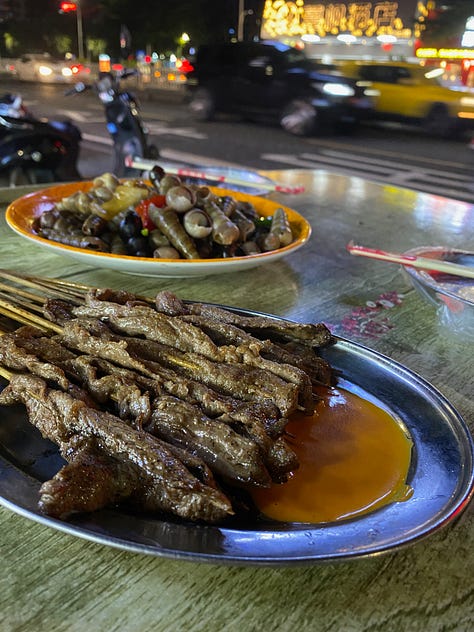




Representative dishes:
Duck rice (鸭仔饭). Top left. In addition to the famed Chicken Rice (more on this below), other poultry like duck or goose also feature prominently in the category. Cooking method is similar: the poultry is poached, then the rice is cooked together with the bird’s rendered fat and the cooking liquid from poaching. In Leizhou, the set comes with a bowl of duck soup as well.
Wet Spicy Beef (湿辣牛肉). Top middle. A newer addition to the area’s BBQ scene, ‘wet spicy beef’ are grilled beef skewers dipped in a spicy (sometimes coconut milk-laced) sauce.
Seafood Rice Noodles (海鲜捞粉). Top right. Seafood a major aspect of the area’s cuisine - from stir fries, braises, to snacks, and rice noodles. Pictured is a flat rice noodle (hor fun) served in a shellfish-based stock topped with various seafood.
Chicken rice (鸡饭). Bottom left. The origin of the world-famed Hainan chicken rice. The variants in the mainland tend to be simpler than its Southeast Asian cousins, opting for somewhat different dipping sauces. The version in the picture was served alongside a sand ginger-soy sauce dip.
Beef & Wild Betel Rice Cake (机粽饼). Bottom middle. This chewy rice cake originated from Teochew migrants to the area. While some of these cakes can be quite simple, pictured is a sweet and savory version with beef and wild betel (蛤蒌叶), an herb which adds an herbaceous and peppery punch.
Layered rice cake (簸箕炊/水籺). Bottom right. This plain layered rice cake is popular throughout the region, with different names and different toppings. It’s made by steaming white rice batter in layers using a bamboo tray or metal sheet. It can be eaten alongside garlic soy sauce, bean paste, garlic oil, Chinese chive oil, or peanut oil; and topped with toasted nuts, preserved mustard green, pickled daikon, minced pork, and/or dried shrimp.
Hainan Province


The largest city in Hainan, Haikou, is very much within the Coastal (Qin-Lian-Lei-Qiong) cuisine discussed above. That cuisine was listed under Guangdong mostly for convenience, as Northern Hainan might very well be where the center of gravity is there.
In the south — around the tourist haunch of Sanya — is a very mountainous region that was traditionally the home of the Hlai ethic group, a Tai–Kadai speaking ethnic group that’s fascinating in their own right. While these days most of the food commercialized along the coast will serve up tourist-focused fair like coconut chicken hotpot (a Shenzhen invention), you can still find Hlai restaurants within the mountainous interior.
Around Wanning — Xinglong, specifically — there’s a fascinating community of Indonesian Chinese that fled to the mainland to escape Suharto’s purges in the 1960s. We’ve personally never been to the city, so it’s a little difficult to parse how organic the cuisine is to that pocket - or if it’s simply a sort of tourism production. We’ll discuss Straits Chinese later in the post.
Hlai



Representative dishes:
Leaf Banquet (长桌宴). Left. Leaf banquet or “long table banquet” is a festive ritual for Hlai people, with colored rice serving as the centerpiece. Dishes to serve alongside would be their local style of blood sausage, braised palm hearts, grilled fish, etc.
Stir fried banana blossoms (炒芭蕉花). Middle. Banana blossom’s an ingredient eaten widely throughout the tropical Southeast Asia, and Hainan is no exception. In addition to stir frying (pictured), it can also be braised or stewed with meat.
Fermented fish (鱼茶). Right. Similar to other Tai–Kadai groups, Hlai also has a penchant for the sour — notably, fermented fish and fermented meat. This version is freshwater fish fermented with salt and sticky rice — after fermentation, it can be eaten straight or steamed.
Guangxi


The Yong-yu River is the major western portion of the Pearl River system, and as such shares some techniques and philosophies with Cantonese. I sometimes refer to the cuisine as ‘Cantonese’s wilder, kinkier cousin’, and it’s comparatively much less afraid of spicy and sour flavors than the eastern portion of said river system.
Internationally, it’s a cuisine that’s a bit infamous for its tradition of dog meat — in particular, the city of Yulin. And while I don’t partake in eating dog myself, I do have to hand it to the Yulin people: lifting one culinary middle finger high and proud against the collective indignation of the entirely of the west, and your other against the collective disdain of the cosmopolitan cities of Shanghai and Shenzhen? For a small city, that takes some guts. We should all try to learn a little from Yulin.
Moving west, is the Zhuang Area, which extends into Yunnan and, arguably, Vietnam. The Zhuang are a highly sinicized Tai-speaking ethnic group that are thought to have been the province’s original inhabitants. This is one of those ‘culinary continuums’ where it’s often not completely clear with where this region begins, and the Yong-Yu River ends. The food, however, is starting to look radically different from Cantonese, with incredibly strong local ethnic influences — particularly love of sticky rice.
Guibei is a stunningly gorgeous pocket of the country, and was difficult to categorize. There’s similarities with both Yong-Yu River (rice noodle heaven) and South Guizhou (a love of the chili pepper), but has enough unique dishes - e.g. Liuzhou Snail Noodle soup, incredibly popular well throughout China these days - that we marked the area as distinct.
Yong-Yu River

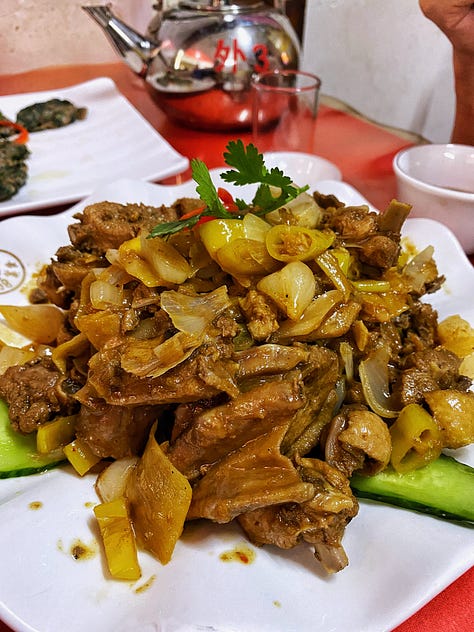




Representative dishes:
Ol Buddy Noodles (老友粉). Top left. The laoyou ‘ol buddy’ flavor profile is a mix of garlic, sour bamboo shoot, pickled chili, and Chinese fermented black soy bean. The original version of the dish was a pork noodle soup, but over the years rice noodles (pictured) also became quite common, and its popularity inspired many other dishes like ‘ol buddy’ rice cakes, snails, stir fried beef, etc.
Lemon Duck (柠檬鸭). Top Middle. A classic Guangxi truck driver dish that over the years became signature to Nanning city. It consists of a braised duck that leans on very Cantonese-feeling technique at first blush, but seasons heavily with preserved lemon and Guangxi’s dried Murraya fruit (鸡皮果).
Paper Wrapped Chicken (纸包鸡). Top Right. Actually an invention from the city of Ngchow (what we selected as westernmost portion of the Cantonese culinary sphere), but quite popular in Nanning as well. This chicken is first marinated, then wrapped with a type of paper meant for culinary use called yukou paper (玉扣纸). It’s then deep fried low and slow — the final result being texturally similar to roast chicken (albeit one that’s been cooking for a while in its own juices).
Breakfast Rice Noodle Soup with Guangxi-style Char Siu (叉烧粉). Bottom left. A simple breakfast of pork stock and flat rice noodles. It’s topped with an array of sour and spicy pickles, together with Guangxi style Char Siu BBQ Pork - a heavily spiced and deep fried Char Siu variant.
Guangxi-style Cheongfun (广西肠粉). Bottom middle. Similar at its core to the classic Cantonese cheongfun rice noodle rolls, but with bolder flavors and topped with a very ‘Yong-Yu’ herb — purple perilla leaves.
Nanning-style Zongzi (粽). Bottom right. Yong-Yu River Zongzi — sticky rice dumplings — are similar in style to western bit of the Cantonese world, i.e. around Ngchow and Zhaoqing. This swath uses sticky rice and shelled mung beans as a base, but what makes the Nanning variant stand out is the addition of kourou (扣肉) — deep fried-and-braised tender slabs of taro and pork belly slab. The package is then tightly wrapped in leaves and cooked for hours.
Guibei



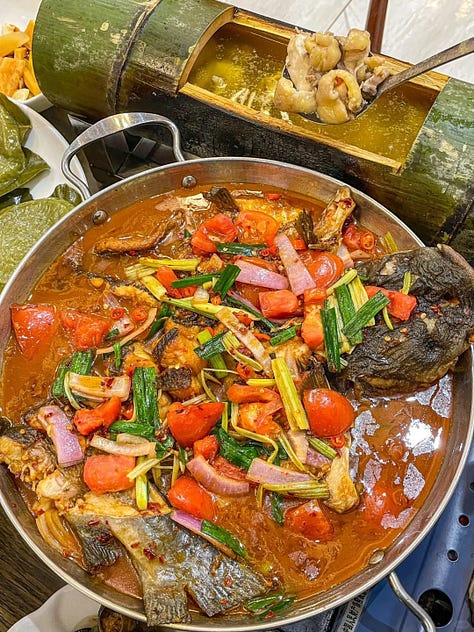


Representative dishes:
Luosifen, Snail Rice Noodle Soup (螺蛳粉). Top left. The Liu River that flows through Liuzhou city also brings in one of the most important ingredients to the city — fresh water snails the famed luosifen noodle soup. The soup consists of a bowl of rice noodles, served in a snail stock, and topped with sour bamboo shoots and chili. There’s a meme that the dish is ‘stinky’ but that’s mostly a function of low quality mass produced or packaged varieties: the luosifen authentic to Liuzhou doesn’t have much of an odor at all.
Guilin Rice Noodles (桂林米粉). Top middle. Guilin rice noodles (at least in Guilin itself) is served as a mixed noodle with soup on the side. The rice noodles are mixed with fermented bamboo shoot, peanuts, scallion, and topped with chili oil and crispy deep fried pork belly (锅烧).
Horse Meat Rice Noodles (马肉米粉). Top right. …not a typo. Yes, horse meat. A quite traditional dish, this rice noodle is served topped with a cured horse jerky, within a horse bone broth.
Beer Fish (啤酒鱼). Bottom left. If a traveler finds themselves in the (gorgeous, admittedly) tourist town of Yangshuo, beer fish may be a their first introduction to the “local food”. While undeniably a bit of a tourist dish, it’s representative nonetheless of certain characteristics of the region: love of chili, love of fish, both cooked in the town’s special local tea tree oil.
‘Eight Treasure’ Beef (牛八宝). Bottom middle. As a restaurant concept, “Eight treasure beef” joints will lay out various parts from a cow for you to choose from. Sour and spicy, the dish is either eaten wet as a hotpot or fried up dry as a dry pot.
Sour Tripe (牛肠酸). Bottom right. Similar in form and philosophy to Cantonese niuza beef skewers, albeit seasoned much more heavily in the direction of spicy, and, well, sour. The skewers are often eaten ‘omakase-style’, with eaters gathering around a vender serving directly out of a big pot of bubbly red soup.
Zhuang Area



Representative dishes:
Five Color Rice (五色糯米饭). Left. Culturally, the five colors — black, purple, white, yellow, and blue — each represent their own sacred meaning to the Zhuang people. Traditionally, this colored rice is eaten for rituals and important festivals, but nowadays you can find it at markets throughout the year. It can be eaten straight, formed into a rice balls, pounded into rice cakes, or eaten with sausage and pickles. These days, it’s not unheard of for Han people in the area to turn it into a sort of Cantonese-style stir fried sticky rice, complete with pork, sausage, peanut, and scallion.
Longlin Chicken Rice Noodle Soup (隆林鸡粉). Center. This is a noodle soup that’s suspiciously similar to pho ga in Vietnam — though perhaps not overly surprising as the town of Longlin isn’t all that far from the Vietnam border. The chicken rice noodle soup can be topped with herbs and/or sour and spicy pickles.
Yaba, Wrapped Duck (鸭把). Right. Yaba, literally meaning “duck handle”, is a specialty around the Hechi city. It contains duck meat, duck stomach, pear, cucumber, Thai basil, all wrapped together with ginger leaf. The dipping sauce is made with duck blood (OG version uses raw blood), ginger, and sour pickles.
Guizhou


Guizhou is a difficult province to map, as altitude is a much stronger predictor of food than latitude and longitude are. It’s an incredibly rugged, mountainous province that historically served as an imperial outpost, a pit stop on the way to Yunnan and its productive tin mines. Han Guizhou consists of the lowlands, and today is centered around the cities of Guiyang, Zunyi, and Anshun.
The food is heavily seasoned. There’s an old, increasingly worn out saying in China that “the Sichuanese can handle their heat (四川人不怕辣), that the neighboring Hunan province isn’t afraid of their chilis (湖南人辣不怕), but that people from Guizhou are afraid of food that’s not spicy enough (贵州人怕不辣)”. I’ve reluctantly repeated it on our channel before, though I’m not even sure how accurate it is (I might lean towards lower-river Sichuan as being the hottest, and I’ve also seen the quip presented in different ways).
Regardless, it certainly belongs to the category — you could definitely use Sichuanese food as a mental starting point. But layered onto that are influences from ethnic groups from the surrounding mountains, particular with regards to various ferments: Fermented Tomato Catfish soup being probably the most famous. If Yunnan food is a chunky stew of different ethnic cuisines, you could maybe think of Guizhou food as something a bit more blended.
Still, once you get up into the mountains — in Dong, Bouyei, and Hmong (Miao) Guizhou — things become increasingly less “Han”. Dong Guizhou, for instance, has flavors like fermented shrimp and niubie — flavors that, to me, harken much closer to Laos and Thai Isaan than they do neighboring Sichuan. While these multi-ethnic highlands are ubiquitous throughout the province, they are particularly concentrated in South Guizhou.
Han Guizhou


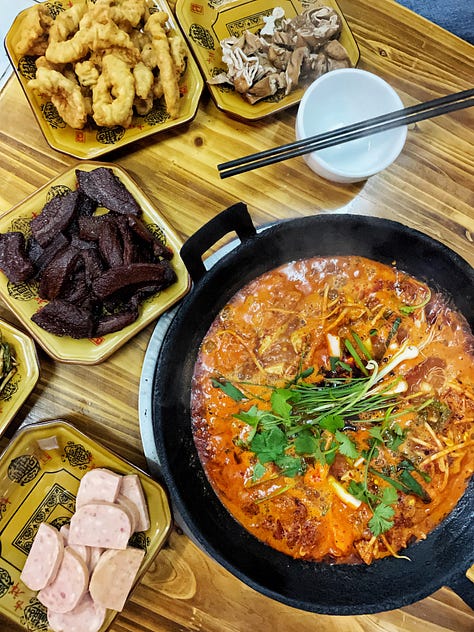
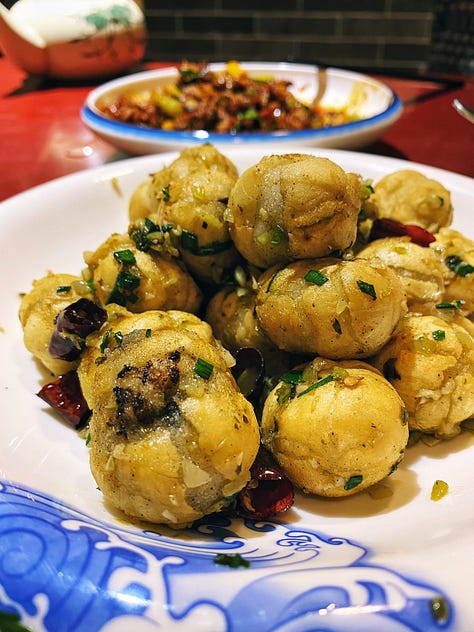

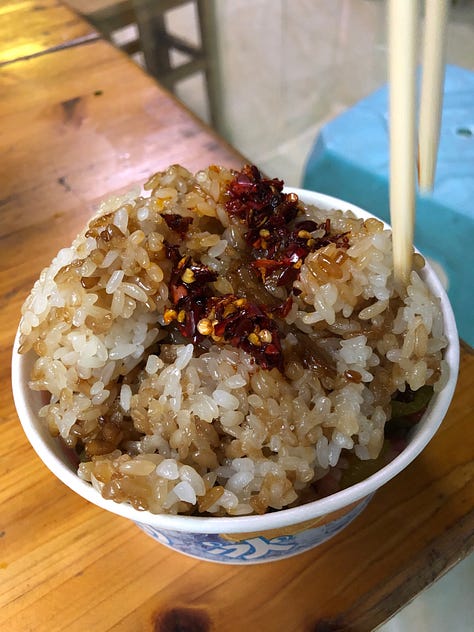
Representative dishes:
Anshun Flaky Baozi (安顺破酥包). Top left. The city of Anshun was an important military outpost since Ming Dynasty, and as such has strong Han food traditions - these flaky Baozi being among them. The flakiness comes from laomian (Chinese style ‘sourdough’) and laminated with lard. Pictured is our favorite filling - the “three delicacies” of scallion pork, washed bean paste, and perilla seeds.
Goat Rice Noodle Soup (贵州羊肉粉). Top middle. A popular rice noodle soup throughout Guizhou, and has since spread all across China. It’s made by stewing large chunks of goat meat and organ in with a special mix of spices (a spice pouch of 36 spices, give or take). Once done, the goat meat’s taken out, wrapped up with cloth, and pressed to firm up before thinly slicing into thin pieces. Upon ordering, the cook’ll quickly blanch rice noodles in hot water, pour over the goat stock, and top with few pieces of goat meat and organ. Goat rice noodle soup has four major schools in Guizhou – Shuicheng (水城), Xingyi (兴义), Jinsha (金沙), and Zunyi (遵义), respectively. Jinsha claims to be the original. The one in Shuicheng features fragrant chili oil and chili crisp, Xingyi tops with a special fermented wheat sauce, and Zunyi mixes deeply toasted chili flakes into the soup itself.
Douchi Hotpot (豆豉火锅). Top right. Perhaps could be thought of as half a hotpot, half a sauce. The base of the pot is made with minced pork, lightly fermented soybeans, and a preponderance of chilis. Upon ordering, the pork’s fried at the table to first render out some oil, then fried together with said chilis and the titular fermented soybean. Pork stock is then added, and the meal continues as a hotpot would. As the concoction reduces, you complete the meal by mixing the progressively thicker soup over rice.
Deep Fried Tangyuan with Fermented Mustard Greens (酸菜炒汤圆). Bottom left. This dish is a bit infamous, belonging to the so-called “dark cuisine of China” (黑暗料理) according to the Chinese internet. It consists of sweet, black sesame filled sticky rice balls, deep fries them, and then stir-fries that with fermented mustard greens and dried chili pepper (and seasons with a non-insignificant quantity of MSG). It feels weird because it is kind of weird. I’d grant that it might be closing in on the Chinese equivalent of fair food, but it’s also - in my humble opinion - actually quite delicious.
Si Wa Wa (丝娃娃). Bottom center. A spring pancake rolled up with an array of fillings including vegetables, pickles, and tofu products… eaten together with a characteristic sauce made from a fermented sour soup. The name itself (lit. ‘silk baby’) refers to wrapping a baby in swaddling cloths - sort of a stretch, but hey.
Breakfast Sticky Rice Bowl (贵阳糯米饭). Bottom right. The breakfast sticky rice bowls ubiquitous to the morning streets in Guiyang city were originally a sticky rice balls - something meant for the road and mixed with lard, soy sauce, and Cuishao, Guizhou-style cracklins. Over the years, it become increasingly common to see it in bowl form, with an ever increasing quantity of various toppings… kelp salad, shredded potato, deep fried peanut, fishwort, pink pickled daikon, sweet Cantonese sausage, etc etc etc.
South Guizhou



Representative dishes:
Fermented Tomato Catfish Soup (酸汤鱼). Left. Originally a Hmong and Dong people’s way of eating, the fermented tomato base make use of small, sour local tomatoes (an incredibly sour cultivar called ‘wild tomatoes’, whose botanical name still eludes us). When cooked, it’s often mixed with sour fermented chilis and a ‘white sour soup’ that’s made from fermenting rice cooking liquid. It can be a base for cooking meat — catfish hotpot, most famously — or alternatively a starting point for a rice noodle soup (酸汤粉).
Fermented Shrimp Paste Beef Pot (虾酸牛肉). Center. The most famous fermented shrimp paste — “xiasuan” — is from Dushan county in south Guizhou. Xiasuan consists of a mix of small fresh water shrimp, fermented with chili and sticky rice wine. The most classic way of eating is to stir fry it with beef and serve as a dry pot. Other ingredients can then be fried up together from this base such as konjac jelly, lotus root, potato, etc.
Niubie (牛瘪). Right. Another ‘infamous’ dish that perhaps belongs to Chinese internet’s “dark cuisine hall of fame”. This dish belongs to a category of dish called bie or pie. It’s made by feeding a cow or goat a number of herbs before slaughter, then collecting them from the first stomach immediately after killing the animal. This digested herb liquid is then used as a base, into which the meat and organs from the animal will then be added. Bie appears in many contexts throughout the Southeast Asian Massif, but in Guizhou is often served in hotpot form. In my personal opinion, the Guizhou version is less challenging than the above description might have you believe — it’s more herbaceous and less bitter than some of its Southeast Asian cousins.
Yunnan


It’s probably fair to say that Yunnan has the most culinary diversity of any province in China. While our map contains a similar number of cuisines within Guangdong, that’s largely because we’re personally quite familiar with Guangdong. We also marked a lot of divisions within Zhejiang, but that’s because that province has some of the richest culinary history in the country (so, they like to delineate a lot of sub cuisines).
But really, when it comes to sheer density of distinct dishes? This is it. What Papua New Guinea is to language, Yunnan is to food.
The cause of the diversity is no mystery. Yunnan, historically, was (1) reasonably agriculturally productive, but at the same time (2) insanely difficult to traverse. It’s rocky all over, certainly, but doing a lot of the heavy lifting was the notoriously treacherous Hengduan Mountains — a range which historically cut Yunnan into three distinct trading networks.
West Yunnan traded just as much with Upper Burma and the Shan hills as they did with Kunming. Pu’er-Sipsongpanna had a similar relationship to the south, to Lanna in Thailand (Honghe is a bit of a hodgepodge of ethnic groups and is hard to categorize). The Kunming plateau was solidly within the Chinese trading network, and so Han Yunnan shows a number of similarities with Guizhou and Sichuan. Up in Dali and Lijiang, however, you’re really starting to see the influence of the Tibetan plateau (and a bit of influence from Tibetan traders as well).
And slicing through them all was the Hui Muslim caravans, which bridged the province not just internally, but also out to Burma, Thailand, and, of course, China proper.
If anything, the regional distinction on our map might be underselling the diversity. After all, Yunnan’s got 25 ethnic groups nestled inside — you could easily make the argument for 25 distinct cuisines.
Han Yunnan




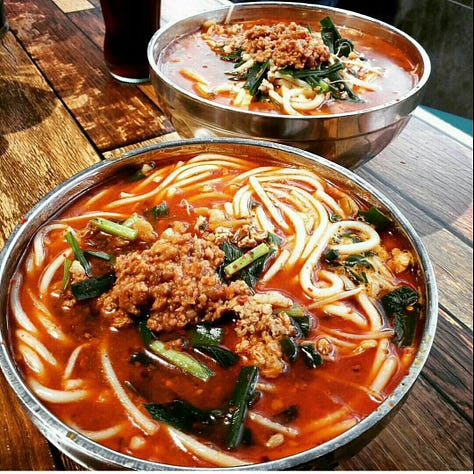

Representative dishes:
Grandmother’s Mashed Potatoes (老奶洋芋). Top left. Potato being among the staple carbohydrates of rocky Yunnan, there’re countless ways the new world crop is enjoyed. Grandma’s mashed potatoes is probably the most famous - mashed potatoes mixed with sour pickled mustard green, common fennel, and smoked Chinese bacon.
Shao Er Kuai (烧饵块). Top center. A thin grilled rice cake which’s a popular street food item throughout Han Yunnan. Traditionally, it’s enjoyed topped with various sweet-savory sauces, toasted peanut and sesame, then wrapped around a youtiao deep-fried dough stick. Nowadays however, on the streets of Kunming, the thing can very much also function as a sort of… Yunnan rice batter burrito - stuffed with hotdog and fried egg, as pictured.
‘Fresh’ Fried Chicken (生炸鸡). Top right. Deep fried marinated chicken — named ‘fresh fried’ as it’s fried sans batter (and only a dusting of starch). Often served on top a bed of deep-fried mint.
Wandoufen (豌豆粉). Bottom left. A noodle jelly made by soaking, grinding, and cooking dry peas. There’s a number flavor profiles for wandoufen in Yunnan — the one pictured sits inside a a sauce of brown sugar vinegar, garlic water, soy sauce, and chili oil.
Little Pot Rice Noodles (小锅米线). Bottom center. Spicy ‘little pot’ rice noodle joints dot Kunming city, slinging thick rice noodles swimming in a base of pork stock, chili oil, Yunnan-style sour fermented mustard greens (酸腌菜) and a deep, fermented sauce called Zhaotong sauce (昭通酱).
Crossing the Bridge Rice Noodles (过桥米线). Bottom right. A general must for those on the Yunnan tourist gauntlet, there’s various theories on the origin of the iconic name. The one that makes most sense to us is that the requisite cooking time for all the items you put into your bowl of scalding-hot broth tableside — rice noodles, pork, ham, quail egg, etc — should be as short as crossing a small bridge.
Hui Yunnan



Representative dishes:
Niuganba Beef Jerky (牛干巴). Left. A widely beloved ingredient and originally a travel food for those traversing the rugged Yunnan mountains. Often eaten by thinly slicing then deep frying, or alternatively roasting over a fire and then pounding into strings. Incredibly fragrant, the oil that’s used to deep fry the jerky is quite valued in Yunnan home cooking.
Goat Soup (羊汤锅). Center. A giant pot of goat soup that can often be sighted these days at the province’s weekend farmers markets, it was traditionally a festival dish for both the Hui and the Yi people. It can be enjoyed in soup form, noodle soup form, or even hotpot form. Almost always topped with a big fistful of mint.
‘Big Crisp’ Beef Noodle Soup (大酥牛肉面). Right. The name ‘big crisp’ (大酥) to a cooking technique of first deep frying beef, followed by cooking in a braise flavored with a deeply savory fermented sauce (like Tangchi sauce or Zhaotong sauce) and a spice mix based around Star Anise and Tsaoko. It can be served directly as a dish or ladled over a bowl of noodle soup, like pictured.
West Yunnan






Representative dishes:
Wa People Shouzhuafan (佤族手抓饭). Top left. Pictured is a festive leaf banquet of the Wa people, featuring their beloved fermented soybean cake (also found in North Thailand and Shan State Myanmar) fried in minced pork and lard, cured ribs and sausage, and other various sides.
Yunnan-style Lahpet Salad (茶叶豆). Top center. If you’re familiar with Burmese cuisine at all, you might be familiar with their famed Lahpet — fermented tea leaves. West Yunnan also makes use of this iconic Burmese ingredient, mixing with tomato, fresh chilis, deep fried split pea, and a non-insignificant quantity of shredded cabbage.
Achang People’s ‘Crossing the Hand’ Rice Noodle (阿昌族过手米线). Top right. The Achang people are a small ethnic group living on the border with Myanmar, centered around the small town of Husa. While the group is most famous for their knife making, their “crossing the hand rice noodle” has become a relatively popular item in the border town of Dehong. It’s eaten by assembling a bite of rice noodle together with various toppings within your palms, a bit reminiscent of how Khanom Chin is enjoyed in pockets of Thailand. The rice noodle itself is made with local red rice, the sauce made with finely chopped grilled meat and pea noodle jelly. It’s also served with “sour water”, made by fermenting rice water and daikon leaves.
Xidoufen porridge (稀豆粉). Bottom left. A thick porridge made from dry split peas (same pea as the wandoufen noodle jelly above), xidoufen is a much-beloved breakfast item in the area. Usually topped with garlic oil, toasted peanut and sesame, and sour pickled mustard green. It can be seen served with rice noodles (pictured), or without. Often served alongside youtiao deep fried dough stick.
Fried Banana Blossoms (炒芭蕉花). Bottom center. A common ingredient in Yunnan’s warmer southern and western climate zones, banana blossom can be eaten in various ways. Pictured here is one stir fried with the area’s fermented soy bean cake and chili - absolutely awesome to devour alongside white rice.
Sour Vegetable Soup (酸扒菜). Bottom right. Variants of ‘sour vegetable soup’ can be found throughout the Tai-Kradai world all the way from Yunnan to Lanna in North Thailand. The west Yunnan style braises vegetable together with potato and sour fermented longbeans.
Pu’er-Sipsongpanna


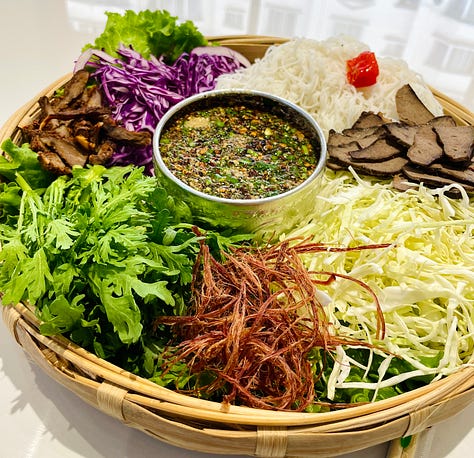
Representative dishes:
Dai-flavor Salads (傣味凉拌). Left. Echoing their linguistic brethren south of the Chinese border, the Yunnanese Dai people love their pounded, mixed cold dishes — seasoned, of course, with vociferous quantities of chili, garlic, and lime. Over the years, their cold salads became a hit with both tourists and local Han Yunnanese… beginning to take on some Sichuan influence, such as the inclusion of a sort of Sichuan-adjacent red chili oil. Extremely common in markets throughout Yunnan nowadays, the chicken feet version is the OG variant that sparked the popularity.
Baoshao Grilled Meat (包烧肉). Center. ‘Baoshao’ refers to Dai cooking method whereby ingredients are wrapped in leaves and grilled to steam the contents. Practically anything can be ‘baoshao’d’, from from meat, to veg, to organs, to mushrooms, to tofu. Pictured is a baoshao of meat mixed with various herbs and chili.
Sa (撒). Right. Sa is a type of watery dip. In Yunnan, it’s often made by mixing finely minced herbs (Chinese chives, laksa leaves, culantro, etc) with pounded or minced meat (e.g. beef, pork, or fish), and then eaten with thin rice noodles. Bitterness is a highly valued flavor in Sa, thus you can also see Sa made from bitter fruit or the aforementioned half digested herb from cows. That said, more popular among non-Dai people in Yunnan tend to be the sa that lean instead into the sour: pictured here is a Sa made with lemon and beef.
Honghe



Representative dishes:
Hani People’s Grilled Fish (哈尼烤鱼). Left. The Hani people lives among the treacherous Ailao portion of the Hengduan range, where they built the UNESCO-famous rice paddy terraces. And within those gorgeous rice terraces, fish grow in the ponds right alongside the rice. One common way to enjoy this fish is grilling - pictured is a saucier version as you might see it at restaurant outside of the area, but in Honghe proper it’s often seen drier, with less sauce and oil.
Dipping sauce Chicken (蘸水鸡). Center. An important festival dish to the Hani people - this dish is (as the name suggests) much more about the dipping sauce than the bird itself. Pictured is a dipping sauce made by mixing a bevy of local herbs, cooked chicken blood, giblets, liver, stomach, intestines, and hard boiled eggs.
Peanut Milk Soup (花生汤). Right. Peanut milk is a common savory soup base throughout South Yunnan. The peanut is often ground directly with skin on, giving the soup its signature mauve color. It’s popular to use this as a base for a vegetable dish (pictured), but it can also be mixed with rice noodles and consumed as a breakfast.
Dali

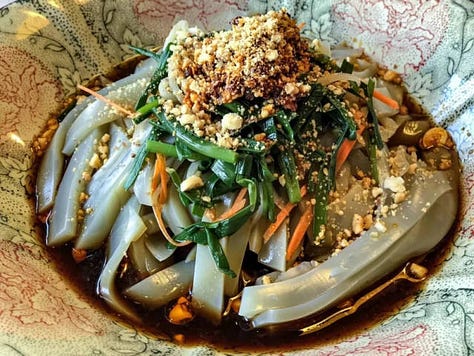

Representative dishes:
Acid Set Cheeses (乳饼). Left. Produced in a similar fashion to paneer, Yunnan cheese consists of goat milk or cow milk and is coagulated with fermented whey. There’s various ways the dish can be eaten, but one classic choice is panfry and serve with Xuanwei ham.
Lentil Liangfen (鸡豆粉). Center. Produced similarly to the wandoufen in Han Yunnan discussed above, albeit using a type of local lentil in place of splitpea. It can be served stirfried, or as a cold dish. Pictured is one with blanched Chinese chive, carrot, and pounded peanuts, all drenched in a spicy vinegar-based sauce.
Suanmugua fish (酸辣鱼). Right. Throughout the Southeast Asian Massif and Tai-Kradai world, much of the food seems to leans on some sort of local ‘sour fruit’ — whether it be Tamarind, Makok, Makrut, or Lime. In Yunnan, the sour fruit of choice is Chinese quince. It can be fresh or dried. Pictured is a Dali classic of freshwater fish from the Erhai Lake braised with chili and the incredibly sour Chinese quince.
The Tibetan Plateau


Tibet. What’s there to say? The very name is evocative of the distance, a traveling destination with a borderline spiritual heft to it. And not just for westerners — in the Chinese psyche, Tibet holds a similar place.
But whether from the direction of Los Angeles or Shanghai, what often gets lost in the romanticism is that Tibet is a… real, actual place. With real, actual people living there, and doing so in an unfathomably harsh environment.
I highly suggest traveling to the Tibetan plateau. You may have heard that it’s difficult for foreigners to travel to Tibet, and it’s true that movement within the Tibet Autonomous region is restricted (possible, but restricted). And yet, the administrative region of “the Tibet Autonomous region” really only consists of the western half of the Tibetan cultural zone, which I would personally center more around Qamdo — extending eastward to Garzê and Ngawa in what’s administratively Sichuan, south to Dêqên in Yunnan, west to Lhasa, and North to Gyêgu (Yushu). Yushu is where I personally centered my time there traveling, and is highly recommended.
Food wise, however, I think it’s reasonable to right-size some expectations. Often I hear people in the west talk wistfully about Tibetan cuisine, impressions quite often laced with quite a bit of exoticism. I cringe a little inside when I see hipster fusion bars in America label their sriracha-laced dumplings as ‘Momo’ on their menus. Survival on the plateau is no joke, and Tibetan cuisine does an incredibly admirable — tasty, even! — job in aiding that project.




Representative dishes:
Tsampa (རྩམ་པ/糌粑). Top left. A staple grain of roasted barley flour that’s eaten in a number of ways - sometimes practically straight, simply mixed with a bit of water.
Gyuma, Blood Sausage. Top right. A blood sausage traditionally made from the let blood of an unkilled Yak, mixed with Tsampa as a filler.
Momo (མོག་མོག/馍馍). Bottom left. Traditionally stuffed with a bit more humble fare like potatoes, as time goes on Tibetan Momo seem to have taken on an increasingly dumpling-like identity. In neighboring Nepal, you can find interesting fusion-y applications like Momo served in various Northern Indian curries, a practice that’s also been replicated in various tourist haunches in China.
Tibetan Butter Tea (བོད་ཇ/酥油茶). Bottom right. At times a bit of an acquired taste, Butter tea is a mixture of brewed Yunnanese Pu’er, freshly churned yak butter, and salt.
Sichuan and Chongqing


Sichuan is a regional cuisine that is quickly becoming a national one. If you were walking in blind to a random restaurant anywhere in China these days, the probability that it’d have at least some Sichuan fare somewhere on their menu might be roughly 50/50.
It’s a cuisine forged on migration. In-migration from the resettlement of Sichuan, Chongqing’s role as the wartime capital, and its historical status as a breadbasket in China; out-migration during China’s post ‘78 boom as Sichuan people streamed to the coast to look for work.
But also during the 1980s, something else happened - Sichuan cuisine was actively standardized, promoted, and commercialized by the province’s local culinary associations. The Sichuan restaurant became an ecosystem that could be bought into - not quite a turn key operation, but almost. If you’re someone with a little bit of money, a desire to open a restaurant, and no direct F&B experience, you have two logical not-hotpot paths to follow: the Cantonese restaurant, and the Sichuan restaurant. Recipes and menus are widely available for purchase. Equipment is standardized. Training is standardized. It’s certainly no accident that these are the two cuisines most available outside of China as well.
But it should be noted that within the modern restaurant environment, there ended up being a bit of a mishmash effect. Dishes seemed to be selected from around Sichuan, but in the province itself, there tends to be much more regionality.
Sichuan chefs tend to divide Sichuan cuisine into three schools. The Upper River Gang (上河帮) is centered around the Chengdu plain, and so (predictably) the cities of Chengdu, Meishan, and Leshan. Many of the classic Sichuan dishes that you know and love originally hail from this area - Mapo Tofu, Twice Cooked Pork, Kung Pao chicken, etc.
The Lower River Gang (下河帮) was borne out of the gritty trading towns that dot the upper reaches of the Yangtze river, and is centered around Chongqing. If the Chengdu is wing #4 on the Hot Ones gauntlet, Lower River is wing #7. Much more comfortable in the upper reaches of the Scoville scale, lower river Sichuan might conform a bit closer to the international stereotype of Sichuan cuisine as fuck-you-level-spicy.
In the south of Sichuan there is the Salt Gang (盐帮菜) school, whose name might take a touch of explaining. Historically, salt was a precious commodity in China, and the city of Zigong was a major epicenter of the trade during the Qing dynasty. The ‘gang’ (帮) in these three cuisines refer to the merchant groups that controlled various reaches of the Sichuan river system, and the Salt Gangs controlled the area around Zigong, Luzhou, and Yibin - and did develop their own cuisine.
Still, in modern times, the Salt Gang shares some philosophical similarities to the Upper River, so could perhaps be lumped together if you were feeling lumpy.
In the south of Sichuan, however, there’s a lesser known little ‘nub’ that juts down into Yunnan, centered around Xichang. This area is perhaps a little more similar to food in Yunnan than it is Sichuan proper, being heavily influenced by Yi people food (and so we called Yi Sichuan).
Upper River Gang
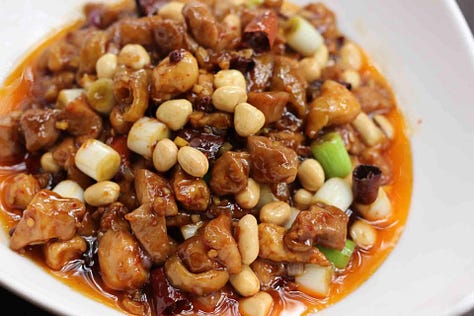





Representative dishes:
Kungpao Chicken (宫保鸡丁). Top left. Sichuan cuisine classically consists of 15 flavor profiles (or alternatively up to over 30, depending on who you ask), Kungpao is functionally one of them: the Hula ‘toasted spicy’ (煳辣) flavor profile. Characteristic to this flavor profile is to fry the dried chili until almost burnt for a deep toasted fragrance. The dish has many, many schools, but the most common add-ins include Chinese leek and deep fried peanuts.
Chili Oil Wonton Soup (红汤抄手). Top center. Wontons are called ‘chaoshou’ (抄手) in Sichuanese cuisine - they can be dry (i.e. mixed with chili oil) or wet (i.e. in soup, also with chili oil). Pictured is the wet variant, but the dry version is the most ubiquitous.
Twice Cooked Pork (回锅肉). Top right. Like Kungpao chicken, twice-cooked pork is one of those classic dishes that everybody has opinion on. Consisting of stir-fried boiled fatty pork - the specific cut is a matter of great debate - the foundational flavors of the dish are the a mix of Sichuan chili paste (Pixian Doubanjiang) and green garlic.
Mapo Tofu (麻婆豆腐). Bottom left. Finishing the trifecta of “Sichuan dishes that everyone has an opinion on”, Mapo Tofu has a long and varied history but at its core belongs to the mala spicy and numbing flavor profile. The dish consists of tofu simmered in a broth of crispy minced beef, Sichuan chili bean paste, chili powder, and finished to taste with Sichuan peppercorn power.
MSG Noodles (味精素面). Bottom center. A street food classic from Leshan city south of Chengdu. This mixed noodle highlights the use of MSG, which was considered a new and novel ingredient at the time of the dish’s invention (the 1940s). Mixed in are also the Sichuan noodle usual suspects of chili oil and yacai - fermented mustard green.
Zhangcha Smoked Duck (樟茶鸭). Bottom right. A classic smoked duck in Sichuan that’s made by marinating, cold smoking with camphor and tea, steaming, and then finally deep frying the duck. There’re some argument around the name ‘Zhangcha’, one side believing that the zhang refers to the camphor (樟树) that's used for smoking, and the other believing that it refers to using tea from Zhangzhou (漳州). Our vote goes for the former.
Lower River Gang



Representative dishes:
Wanzhou Grilled Fish (万州烤鱼). Left. A dish that’s spread far and wide from its origins in Wanzhou city, this grilled fish has become a late night BBQ staple in all four corners of the country. It’s made by grilling marinated fish over charcoal, then bringing to the table in a bath of chili and spice ladened sauce - braising slowly over a small fire as you munch on it. While you can find various choices like pickled chili and ‘sauce flavored’, pictured is the classic – “mala”, numbing-spicy flavor.
Maoxuewang (毛血旺). Center. A spicy dish with a name that’s confused non-Sichuan people and auto-translate servers alike. It means cow stomach (mao refers to tripe, i.e. maodu, 毛肚) and blood (xuewang, 血旺, is Sichuan dialect for congealed blood cake). Originally it was simply just organ and blood cooked in a numbing chili broth, but over time became increasingly loaded with ingredients like spam, potato, tofu, etc.
Chongqing Hotpot (重庆火锅). Right. A Sichuanese dish since become a national and even international sensation. It was originally a humble dish that leaned on cheap beef and chili bean paste… it’s since reached the dizzying heights of the Scoville scale, the hotpot version of Da Bomb, a rite of passage, and a cultural institution.
Salt Gang



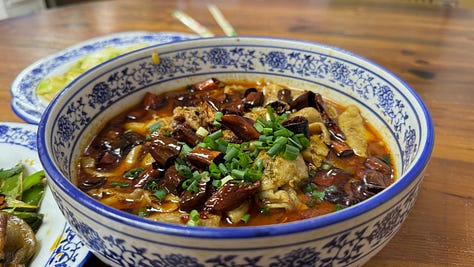


Representative dishes:
Tofu rice (豆花饭). Top left. Throughout Sichuan and Guizhou, around lunchtime you can find people streaming into their tofu rice joints - enjoying a savory douhua ‘tofu pudding’ over rice together with various chili-laced dipping sauces. The Sichuanese South is particularly famed for their love of this tradition, with localized dipping sauce variants such as the Fushun version (laced with Chinese patchouli) and the Luzhou version (brightens things up with mujiangzi oil).
‘Cold eaten’ Beef (冷吃牛肉). Top center. Thinly sliced beef that’s deep fried until dry and jerky-like and soaked in chili oil. Popular as a restaurant dish, a snack for the road, and goes phenomenally with the local area’s baijiu liquor.
Yibin Burning Noodles (宜宾燃面). Top right. Originally a humble meal for Yibin dock workers, it consists of chili oil, toasted peanuts and sesame, and Yibin yacai. The ‘burning’ in the name is a translation of the character ran (燃), which means ‘to ignite’. There’s various theories on why a mixed noodle would include such a character - the most oft-repeated one is that is was differentiating the noodle as a ‘not-soup-noodle’ dish. That is, that the noodle was not just dry (so, convenient to eat on the docks), but so dry that you could theoretically toss it over a fire and the thing would ignite. Of course, most modern Burning Noodles prove quite stubbornly difficult to set on fire…
Shuizhu Beef (水煮牛肉). Bottom left. A.k.a. “boiled beef” or “chili poached beef”, this is a dish that these days is seen through Sichuan - together with the country at large. The dish comes from the area’s history of salt production, and the oxen that were used as manual labor in the process. The dish was originally a way to use up this tough meat - salt marinated, coated in a generous quantity of sweet potato starch, all poached in a broth heavily seasoned with chili and Sichuan peppercorn.
Fresh Chili Rabbit (鲜椒兔). Bottom center. Rabbit is a popular protein source throughout Sichuan (Chengdu is famed for their snack of spicy rabbit heads). Pictured is a Zigong rabbit dish cooked with fresh chilis, Sichuan pepper, and baby ginger.
Crispy meat soup (酥肉汤). Bottom right. Surou - ‘crispy meat’ is deep fried pork by any other name. Preferably made with fatty pork, it deep fries with a seasoned egg/sweet potato starch batter. It’s an ingredient that can be purchased directly from the market in Sichuan, and there’s various ways that they’re incorporated into meals. Those outside of Sichuan are often introduced to the ingredient as a choice on Chongqing hotpot menus, but in South Sichuan home cooks often like to employ it in quick soups. Pictured is one such soup with pea shoots.
Yi Sichuan



Representative dishes:
Tuotuorou (坨坨肉). Left. Traditionally a festival dish for the Yi people, the name literally means ‘chunky meat’. It can be produced from various meats (pictured is pork), cut into large hunks, and simmered together with a mix of salt, Sichuan pepper, chili, and mujiangzi.
Bitter Buckwheat Baba (苦荞粑粑). Center. Bitter buckwheat (苦荞), a sort of buckwheat that grows well in mountainous terrain, is one of the staple grains of the Yi people. Pictured is a leavened pancake made from this grain.
Yi-style Barbecue (彝族烧烤). Right. While many BBQ styles throughout China lean heavily on various spice mixes, Yi style barbecue focuses more on the ingredients themselves. Pictured is one style whereby ingredients are grilled communally on long skewers over a central charcoal fire.
Hubei


Hubei cuisine is simultaneously underrated, and yet difficult to parse. Poking around the province, there’s undeniably a ton of city-by-city diversity - Wuhan is famous for their breakfast snacks like Hot Dry Noodles (as well as this stuffed Shaomai which might just be one of the best things I’ve ever eaten), Xiangyang is famous for Beef Noodles, and Jingzhou is famous for their Guokui Crispy Pancakes (荆州锅盔).
And yet, all these cities do seem to cluster around certain concepts - beef and fish, steams and braises, a love of the chili pepper, and a rich culture of baijiu drinking at breakfast. Someone more educated on Hubei cuisine than us would likely be able to parse at least a couple of internal divisions, but outside of a brief trip or two to Wuhan, we’re still woefully undereducated.
The one bit that is undeniably a bit different is the mountainous Tujia area around Enshi in the west of the province, which we opted to lump with the similarly mountainous western section of Hunan to the south.






Representative dishes:
Hot Dry Noodles (热干面). Top left. The lifeblood of Wuhan - this noodle dish can be a snack, it can equally be breakfast. Classically a mix of sesame sauce, the braising liquid from Hubei-style beef master stock, chili sauce, and spicy preserved radish.
Doupi Pancakes (三鲜豆皮). Top center. A dish that it seems everyone in Hubei has an opinion on. The yellow ‘sheet’ on top is a sheet of cooked mung beans with egg cracked over it, covering the various fillings - sticky rice, shiitake mushroom, marinated pork, and tofu jerky, among others - below.
Hubei fishcakes (湖北鱼糕). Top right. With the Yangtze flowing down the center of the province and many lakes dotted about, a penchant for freshwater fish is incredibly characteristic of the Hubei province. One very classically Hubei dish is their fish cake, which is made by steaming fish paste and finishing with an egg yolk wash, giving the cake its signature vibrant yellow hue. A must around Chinese New Year in Hubei, it’s an ingredient that can be purchased at the market and then used in various applications - e.g. braises, hotpots, or steamed (pictured)
Beef Noodles (襄阳牛肉面). Bottom left. A dish that bears a bit of resemblance to Sichuan’s Red Braised Beef noodle soup next door, Xianyang’s beef noodles are a somewhat simpler affair which lean heavier on beef - loading up with a generous quantity of sliced beef, and serving in a rich beef broth.
The Three Steams of Mianyang (沔阳三蒸). Bottom center. The ‘three steams of Mianyang’ refer to a mix of fish, meat, and vegetable that’s coated in a spiced rice flour, ala Rice Powder Pork Belly. In the foreground is the similarly classic Hubei steamed dish, ‘Pearl Meatballs’, which are coated with sticky rice.
Deep Fried Lotus Root (干煸藕丝). Bottom right. Lotus root is an ingredient particularly abundant in Hubei, and appears in many forms. One of the most classic soups of the province is Lotus Root and Pork Rib Soup; pictured is a popular drinking snack of crispy deep fried lotus sticks seasoned with chili and Sichuan pepper.
Hunan


If there is one contender to Sichuan cuisine as ‘the national cuisine of China’, it’s probably Hunan food. With working class eateries dotting the country and a strong influence on workplace canteens, makes for a strong challenger.
Put simply, Hunan cuisine proper - which we’ll refer to here as its formal name Xiang - is perhaps the world’s greatest conspiracy to consume unrelenting quantities of white rice. Practically to the dish, it’s so good with rice. When I was the younger workout-bro carb-avoidance version of myself… I didn’t quite ‘get’ Hunan food. But that was clearly because I was doing it very, very wrong.
In addition to being strong seasoned, you’ll notice how ‘finely minced’ a lot of Hunan dishes are. That’s no accident. How Hunan food is best enjoyed, in my current opinion:
Get a big container of rice.
Top, mix, or alternate bites of said rice with your dishes of choice.
Go along for the ride, interspersing it all with a tall bottle of beer or a grown-up-sized class of baijiu.
Meanwhile, in the mountainous Hunan West, you’re starting to get into a cuisine that - like neighboring Guizhou - is quite influenced by the ethnic groups in the area. And perhaps befitting our personal love of Guizhou cuisine, we personally can’t help but be drawn to that section of the province (which is also stunningly gorgeous in parts).
Xiang






Hunan-style Red Braised Pork (红烧肉). Top left. Red Braised Pork is a dish that you can find variants of in practically every pocket of China. The Hunan version insists on starting things with a tangse caramel, and often includes chili pepper in the spice mix. Allegedly Mao Zedong’s favorite dish, ‘Mao-style’ is an elegant banquet presentation of the dish; pictured is a more rustic style which includes lightly fermented soybeans.
Chili Fried Pork (辣椒炒肉). Top center. While many provinces have variations on the theme, Hunan’s is the most iconic. Stir fried pork with spicy chilis - pretty much does what it says on the tin.
Stir Fried Smoked Bamboo Shoots & Chinese Bacon (烟笋炒腊肉). Top right. A dish that packs a real punch of smokiness - cold-smoked bamboo shoots with Hunan style ‘Chinese bacon’, stir fried with chilis and aromatics.
Golden Coin Eggs (金钱蛋). Bottom left. Hard boiled eggs, sliced, then lightly coated with cornstarch and shallow fried. Finished by stir-frying with chili, aromatics, and Hunan’s local variant of Chinese fermented black soybean.
Tea Tree Oil Fried Chicken (茶油鸡). Bottom center. ‘Tea tree oil’ - i.e., camellia oil - is a highly valued cooking oil in Hunan, traditionally reserved for special occasions due to limited yield. While stocks are less limited nowadays, it still tends to be reserved for specific dishes (which are also sold at a slight premium). Pictured here is a ‘free range’ chicken fried in tea seed oil, a classic application.
Fish Rice Noodle Soup (鱼粉). Bottom right. In additional to being incredibly rice centric, Hunan is also a province famed for its rice noodles. Outside Hunan, the most iconic Hunanese rice noodle dish is likely Changde Beef Rice noodles, but pictured is my personal favorite of Fish Rice Noodle soup - specifically the Hengyang version. Found in various pockets around Hunan, the dish consists of rice noodles cooked in with a quick, chili-laced milky fish broth.
Hunan West

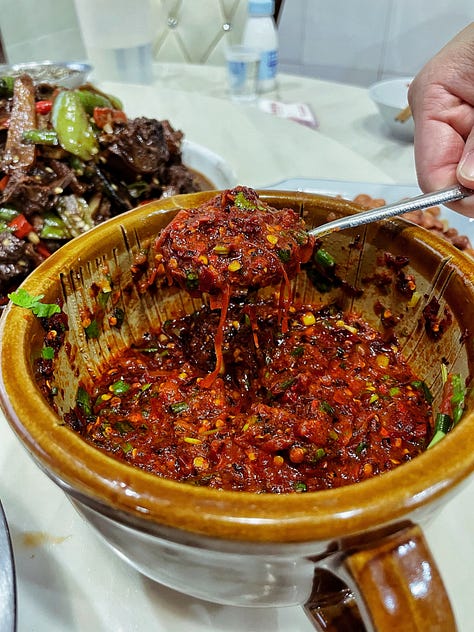




Blood Duck (血鸭). Top left. Blood duck is a dish that you can find throughout Hunan and even down into the north of Guangxi. Pictured is a Hunan West variant which stir fries and braises duck with chili and ginger, finishing the dish with fresh blood to create an emulsified sauce.
Pounded Chili Dip (擂辣椒). Top center. A simple and delicious dip tantalizingly evocative of Northern Thailand. Pictured is a dip of roasted chili and tomato, which is then pounded and mixed with cilantro. Fantastic to eat over rice.
Guoba Sandwich (湘西锅巴). Top right. If you’ve ever wondered if you could fashion a dish to consist solely the crispy rice found at the bottom of a Paella or a Claypot rice — and then took that and turned it into a sandwich with various chili-laced fillings — Hunan West has your answer. “The Socarrat Sandwich” is just as delicious as it sounds, and our recipe on the thing is probably my favorite video we’ve put out.
Mungbean Noodles (锅巴粉). Bottom left. Classic to the area, Mungbean noodles are made by forming a batter with mungbean flour, frying it into a pancake, and then slicing it into noodles. Served in various forms, pictured is the noodle served in soup together with a bevy of toppings.
Fried Bee Larvae (炒蜂蛹). Bottom center. Deep fried insects are commonly seen throughout China, particularly in the mountainous regions. These days often ordered as a drinking snack, pictured is bee larvae fried with chili and deep fried peanuts.
Pickled Radish ‘Snack Bar’ (芷江酸萝卜). Bottom right. A street food classic in Hunan West, the foundation of the snack is the titular sour fermented daikon. You then select various pickles, vegetables, and tofu products, which are then all mixed together with a chili oil-based sauce.
Jiangxi


When I lived in Shenzhen, I’d often meet people from Jiangxi - after all, demographically, Shenzhen is predominantly a mix of Hunan, Chaozhou, Sichuan, and Jiangxi people (any Cantonese influence tends to come from Hong Kong weekenders next door).
Sichuan people are quite proud of their food. Ditto with Hunan and Chaozhou. But when I would ask people from Jiangxi about their cuisine, the common response would be:
“Jiangxi doesn’t have a cuisine”.
…which was a statement that always sort of confused me.
Now, certainly, if you look at the make-up of an average Jiangxi meal, what you tend to find is a food bit of crossover with to the neighboring Hunan province: chilis, small minces, a mass of white rice, all punctuated with a love of the rice noodle. And given Hunan cuisine’s dominance among country’s working class canteens and eateries, I could easily imagine someone from Jiangxi coming to an opinion of “Well, this is just… how people eat.”
And it would be fair, maybe, to lump much of Jiangxi in with Hunan. But given that there’s a number of dishes (proudly) unique to the province… you’d then, I think, have to refer to the whole thing as Hunan-Jiangxi food. A bit of a mouthful, and we’re more splitters anyway.
In the Northeast of the province, however, the mountains are starting to get undeniably different than the lowlands around the capital of Nanchang. This is the home of the famed porcelain town of Jingdezhen, and the food there shares quite a bit with the similarly mountainous area of Zhejiang next door.
In the south of the province, around the city of Ganzhou, things are starting to get rather quite Hakka. A difficult area to categorize. Less of a blending of food, a bit more Jiangxi and Hakka both living together in the same city.
Jiangxi

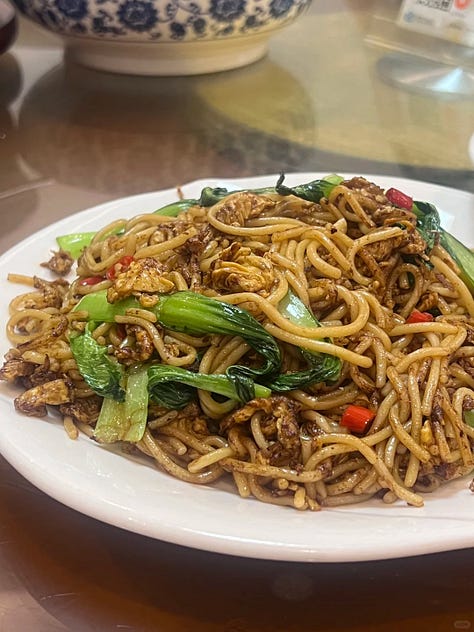
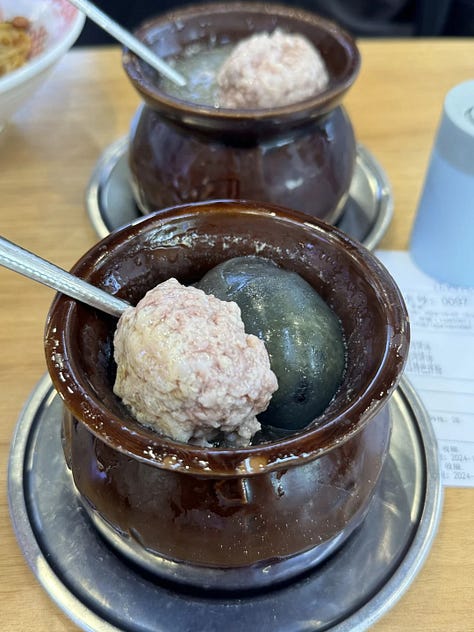
Representative dishes:
Spicy Chicken Feet (辣鸡爪). Left. Homecooking classic of soft braised chicken feet, seasoned with fermented rice and a preponderance of chili.
Jiangxi Chili Fried Rice Noodles (江西炒米粉). Center. Jiangxi, like Hunan, is quite famous for their rice noodles - outside of China, perhaps the many people’s introduction to the province are the dried rice noodles that bear its name. Pictured is a street snack that’s ubiquitous in Jiangxi: stir fried rice noodles with chili and baby bok choy.
Clay Jar Soups (瓦罐煨汤). Right. Perhaps the most iconic sight outside of a Jiangxi restaurant is a massive, human-size clay jar. Inside are smaller jars, as pictured, steamed inside to create the province’s famed double boiled soups. This is one with pork meatball and century egg.
Northeast Jiangxi Mountains



Representative dishes:
Qigao Pancake (汽糕). Left. This local street food consists of a thin layer of fermented rice batter, topped with dried (and reconstituted) bamboo shoots and daikon. Brushed with fermented bean sauce before serving.
Dengzhanguo (灯盏粿). Middle. Dengzhanguo is made by first steaming a rice cake into a ‘lantern-shaped’ little bowl, filling with mushroom, pork, beansprouts, and bamboo shoots, and then steaming the package again. Traditionally a festival dish, it’s now often enjoyed as a street snack.
Acorn tofu (苦槠豆腐). Right. Made from the acorn of the Chinese Tanbark Oak (苦槠), this is a dish that comes from a history of starvation food and can be found in various mountainous pockets throughout South China. The acorns are soaked for weeks, then ground, strained, and cooked down into a jiggly rice cake-like object. Pictured is one chopped up and served with fresh chili and scallion.
Fujian


Eating around Fujian, there was always a certain je ne sais quoi that reminded me of Chinese food in America, and certainly Chinese food in Malaysia and Singapore. The former is subtle, and (assuming that it’s not just in my head) likely came by the way of Taiwan - after all, Taiwanese immigrants in the 70s and 80s were instrumental in crystallizing what we know of today as ‘American Chinese takeout’.
The latter, however, is no puzzle: merchants and settlers from South Fujian - Minnan, or Hokkien - were one of the three major pillars of maritime Chinese in South East Asia (along with the Cantonese and the Teochew, discussed above).
Once upon a time, the city of Quanzhou was the nexus of maritime trade in Asia, visited and written about both by Marco Polo and Ibn Battuta. Food wise, I’m personally probably guilty of being overly drawn to the faint echo of those pathways, but most Minnan people would likely point you more to their famed oyster omelettes instead.
Minbei, the north section of Fujian around the capital city of Fuzhou, is quite distinct from the south. Sweet and sours feature prominently, ditto with the red dregs from fermented rice wine, called hongzao.
The food from the West Fujian Mountains became quite popular in Fuzhou in the 80s and 90s, and expanded throughout China in the form of the chain “Shaxian snacks” - Shaxian referring to a small mountain town particularly famed for their food. If you’ve eaten around China, it’s quite likely that you’ve stumbled into one at some point. The chain is a reasonable representation of western Fujian food, but quality-wise (obviously) pales in comparison to what you can find in the region itself.
Minnan






Representative dishes:
Xianfan (咸饭). Top left. A festive rice dish that, in essence, is cooked pilaf-style. Rice is fried in a base of lard, pork, dried shrimp, dried shiitake and shallot, then water is added and the entirety of the pot is steamed.
Shacha Noodles (沙茶面). Top center. Shacha sauce - a mix of peanut, fish sauce, shallot, chili, sesame, spices, and oil - is thought to have derived from Southeast Asian Satay sauce (though given Satay’s Hokkien linguistic roots, directionality’s hard to determine). The sauce can be used as a flavor base for stir fries, braises, and hotpots - pictured is a noodle soup common in Minnan served with beef and tofu puff.
Curry Beef (咖喱牛排). Top right. An old school dish from Quanzhou, these braised beef ribs are another example of a shacha-based dish, albeit one with (interestingly) curry powder also added to the mix. Thought to have originally been a Hokkien Muslim dish.
Mianxianhu (面线糊). Bottom left. Mianxianhu is made by cooking a gossamer-thin noodle in a soup together with seafood and pork, which ends up to dissolving into an almost congee-like consistency. Classically eaten as a breakfast or a midnight snack, it’s commonly paired next to some youtiao deep fried crullers.
Minnan Oyster Pancake (海蛎煎). Bottom center. A much beloved snack in the area, the traditional Minnan version is a bit more of an acquired taste than the Teochew variant next door. The pancake tends to be egg-less and leans heavily instead on sweet potato starch to arrive at a chewy, gloopy consistency. Often served next to Minnan’s local sweet chili sauce (甜辣椒酱).
Thick Beef Soup (牛肉羹). Bottom right. Thick starch-thickened soups, geng, are quite popular throughout the region, with beef geng likely being the most classic. A very old school dish, beef slices are coated with a generous quantity of sweet potato starch and poached in beef stock - a process that gently cooks the beef, while thickening the soup in the process.
Minbei






Representative dishes:
Lychee Pork (荔枝肉). Top left. Traditionally speaking, ‘lychee pork’ was an elegant banquet dish, whereby pounded pork was wrapped around water chestnut, deep fried, and the whole package was mixed with a hongzao-based sweet and sour — arriving at a ‘lychee-like’ end result. These days, the name refers more generally any Minbei-style sweet and sour pork (which often, brilliantly, include deep fried potato in their mix).
Guobianhu (锅边糊). Top center. A classic breakfast in Fuzhou, guobianhu cooks rice batter on the side of a hot wok, with stock bubbling in the center. After the rice batter forms, it’s then scraped into the soup and all cooked together. Particularly excellent next to some Fuzhou deep fried rice cake (三角糕), as pictured.
Fuzhou Fishballs (福州鱼丸). Top right. Fuzhou fishballs are… a meatball stuffed in a meatball - the inside layer is seasoned pork paste; the outside, fish. Generally served in soup.
Nanjiangan (南煎肝). Bottom left. I’m personally someone not overly fond of the taste of liver, but this liver dish quickly slotted in as my favorite of any, anywhere. Nanjiangan consists of thinly sliced pork liver, flash fried in lard and then stir fried - this one with bell pepper, carrot, and onion.
‘Zao’ Fried Pork (炸红糟肉). Bottom center. ‘Zao’ pork consists of pork tenderloin marinated with hongzao, the neon-red glutinous rice wine lees common to the region. It’s then deep fried with an aggressive coating of sweet potato flour, and served dry.
Deep Fried Spring Rolls (炸春卷). Bottom right. Many places in China have spring pancake. Many places in China also deep fry said spring rolls. But I can’t help but feel that the specific combination of fillings found in Fuzhou — cabbage, carrot, and pork, which I sometimes jokingly refer to as ‘the Hakka Trinity’ — is incredibly evocative of the spring rolls and egg rolls served up in American-Chinese takeout restaurants. Maybe it’s in my head.
West Fujian Mountains






Representative dishes:
Shaxian Wontons (沙县云吞). Top left. Similar in many ways to Cantonese style wontons, Shaxian wontons are a bit smaller, stuffed with solely pork (and not seafood), and opt for a non-alkaline skin. Often served in soup - as pictured - or mixed in with a peanut paste-based sauce.
Peanut Sauce Noodles (飘香拌面). Top center. A classic on the Shaxian snacks menu, these peanut sauce noodles are an addictive mix of scallion lard, peanut paste, and a seasoned soy sauce.
Midongpi (米冻皮). Top right. Midongpi are more or less akin to an un-stuffed Cantonese cheongfun, but served in a very special local sauce called douchiyou (豆豉油). Douchiyou itself consists of douchi, Chinese fermented black beans, simmered in water for hours until completely dissolved. Optionally topped with an aggressively spicy Habanero-like local cultivar of chili.
Shaxian Shaomai (沙县烧麦). Bottom left. A highlight of Shaxian (in my personal opinion), these Shaomai consist of chopped rice noodles and meat stuffed inside of a very thin dumpling skin, and steamed.
Banya (板鸭). Bottom center. Banya duck legs are first lightly smoked, then roasted. They can be purchased at the market and eaten directly, or brought home and steamed to re-heat.
Xiguo (喜粿). Bottom right. To make xiguo, a mix of rice and red rice is ground down to a batter, then steamed to form the ‘dough’. This concoction is then stuffed with pork, dried shrimp, Chinese chives, and pickles, and served in a thin douchiyou sauce.
Zhejiang


Zhejiang, together with neighboring Jiangsu, has some of the richest written culinary history of anywhere in China2. And as such, the food world there really does like to delineate a lot of sub-cuisines.
Some of the differences admittedly might look somewhat subtle to an outsider, but the regionality runs deep. The Hangzhou school, hailing from the largest city in Zhejiang and historically the most dominant, is the cuisine that’s generally synonymous with “Zhejiang food” when recalled in The Big Eight. It’s got a rich banquet tradition, a tradition sometimes derided by its (generally Northern Chinese) critics as ‘too sweet’.
The neighboring Shaoxing is, of course, the source of the famed rice wine that bears its name. Shaoxing wine itself is a dry to semi-dry rice wine that’s long been the source for chefs to balance and remove subtle ‘off odors’ from ingredients… and so maybe it’s no surprise that the go-to drinking food it’s paired with often feature funky, fermented ingredients. It’s might not the best Chinese cuisine for people with sensitive palettes, but if you’re like me and the type that loves indulging in funky cheeses and the like… Shaoxing food can hit a similar spot.
The Zhejiang coast is generally split into two major cuisines - Ningbo and Ou. The latter is a grouping of three cities - Wenzhou, Lishui, and Taizhou - that’s particular renowned for its seafood. Ningbo, the largest city on the coast, has a number of local specialties, but an argument could perhaps be made that it might able to be lumped in with Ou cuisine as well.
The mountains in the south and west of the province are beginning to get quite distinct. Quzhou shares a good bit of crossover with neighboring Shangrao over in the Jiangxi mountains, but the She People autonomous region is generally considered its own pocket. The She People themselves have an interesting history in their own right, and scattered communities exist throughout south China (the largest concentrations being in around Jingning and outside of Ningde in neighboring Fujian).
Jinhua is a difficult city to categorize, and could maybe be thought of as a ‘shatter zone’ between Hangzhou, Ou, and the Jiangxi mountains.
Hangzhou

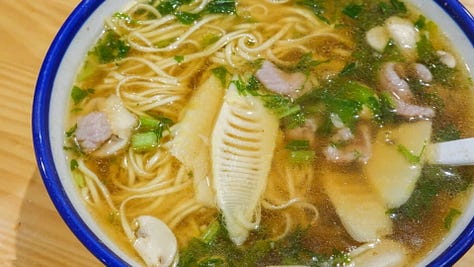

Representative dishes:
Candied Ham (蜜汁火方). Left. An old banquet dish that’s extremely traditional to the Hangzhou school. Jinhua ham steamed in rock sugar and Shaoxing wine, pictured is one also served with lotus seed and Miju dates.
Pian’er Chuan (片儿川). Center. An older, more traditional noodle soup that can be found at practically every noodle shop in Hangzhou. Consists of a classic mix of pork, xuecai pickles, and bamboo shoots.
Longjing Shrimp (龙井虾仁). Right. Small, extremely umami river shrimp, local to the Yangtze River delta. Cooked by deep frying at low temperature, then finishing in a sauce using the famed local longjing tea.
Shaoxing






Representative dishes:
Shaoxing Wine (绍兴酒). Top left. What is known around the world as “Shaoxing wine” is actually one of four different types of Huangjiu rice wine produced in Shaoxing, as we discussed in our Shaoxing wine explainer video — a semi-dry sort referred locally as jiafanjiu (加饭酒), pictured.
Shaoxing Drinking Food (绍兴下酒菜). Top center. While maybe a touch of an acquired taste, a meal consisting of the aforementioned local wine with local drinking snacks is a must nonetheless. Pictured is a bibulous lunch consisting of salted plum peanuts, fried luffa smothered over youtiao crullers, brined chicken, and steamed sweet sausage.
Steamed Double Stinky (蒸双臭). Top right. Amaranth stem fermented with tofu for about a week or so, then steamed. Another entry to the Chinese internet’s “dark cuisine”, this dish would probably be among the most difficult Chinese dishes for the average American palette to accept. In my personal opinion, it does go quite well washed down with some Shaoxing wine, but even for me it’s best enjoyed after a few drinks in.
Fennel Broad Beans (茴香豆). Bottom left. A bit analogous to tea egg, these broad beans are braised in soy sauce, fennel seed, and a grab bag of other spices until soft.
Sauce Preserved Duck (酱鸭). Bottom center. Made by salting and drying duck, soaking in a soy sauce brine, then drying again before steaming to serve. Another excellent drinking food.
Vegetarian Goose (素烧鹅). Bottom right. A dish that comes from the tradition of fancy vegetarian banquet food bound for the Buddhist elite. Pictured is a stuffed version containing mushroom - the ‘skin’ of the ‘goose’ consisting of tofu skin. There is also an unstuffed crispy deep fried version of the dish.
Ningbo



Representative dishes:
Ningbo Braised Three Delicacies (宁波老三鲜). Left. A festive dish that comes from Ningbo home kitchens. At its core a pot of ‘umami stuff’, the ‘three delicacies’ can refer to different things depending on who you ask. Generally, it refers to (1) some sort of vegetable (e.g. napa, cabbage), (2) something round (e.g. egg dumpling, meatball, quail egg), and (3) bamboo shoots. It can also be loaded up with fried fish, tofu products, etc.
Walnut Ginger Pudding (核桃调蛋). Center. Another homecooking classic, a dessert made from ginger juice, crushed walnut, and brown sugar.
Ningbo Rice Cakes (苔条年糕). Right. Ningbo is particularly famed for rice cakes — Yangtze river delta chef may get their wine from Shaoxing, and their their rice cakes from Ningbo. Made from a whole rice batter using short grain rice, there’s many ways to enjoy them - pictured is panfried with green laver seaweed.
Ou



Representative dishes:
Loaded Sticky Rice (温州糯米饭). Left. A classic street food in Wenzhou city, this is a bowl of steamed sticky rice loaded with a dried shiitake &minced pork sauce, dried shrimp, and crispy youtiao bits. Often eaten alongside a savory egg soymilk (咸蛋浆).
Jiashao Fish (家烧杂鱼). Center. Jiashao refers to a method of braising common to the area — i.e., braising in a mix of lard and soy sauce, while seasoning generously with white pepper season. While crab, daikon, tofu can all be jiashao’d, fish is the most classic.
Smashed Shrimp Noodles (敲虾面). Right. Pretty much does what says on the tin — shrimp that are smashed, coated with starch, and then boiled. Served with fresh noodles cooked in a soup base of vegetable, pork, and shiitake mushrooms.
She



Representative dishes:
Black Sticky Rice (乌饭). Left. A traditional She people vegetable dish, this sticky rice is colored black with the juice of sea bilberry.
Edamame Tofu (豆腐娘). Center. Similar in concept to ‘lazy tofu’, this is an uncoagulated cooked down blend of edamame. Seasoned with garlic and chili, and served as a soup
Rice Noodle Sheets (景宁粉皮). Right. A breakfast classic in the area, these are steamed rice noodles in a soup consisting fried egg, pork slivers, chili sauce, and pickled perilla leaves. Pictured is a variant that adds the aforementioned edamame tofu as a soup base.
Jinhua






Representative dishes:
Jinhua Ham (金华火腿). Top left. A ham local to the mountains of Jinhua that bears a striking resemblance in process to Spain’s Jamón ibérico. A dried, unsmoked cured ham, the area makes use of the prized liangtouwu (两头乌) black pigs.
Stinky Tofu Sandwich (炸馒头臭豆腐). Top center. A Jinhua street food classic of stinky tofu stuffed inside of a deep fried mantou bun. Classically a simpler affair stuffed with stinky tofu, chili, and not much else… pictured is a restaurant doing a modern take on a ‘stinky tofu burger’.
Jidanguo (兰溪鸡蛋馃). Top right. From Lanxi, a county under Jinhua. Thin pancake stuffed with pork and a veritable mountain of scallion. As the package is being shallow fried, beaten egg is carefully poured in as well.
Vinegar Chicken (武义醋鸡). Bottom left. Hailing from the county of Wuyi, this is very old dish of chicken braised in their (watered down) local rice vinegar.
Jiuniang Tangyuan (酒酿小丸子). Bottom center. Red from hongzao - the dregs from making Hongqu Red Rice Wine. Unstuffed tangyuan rice balls are cooked in a sweet soup before coloring; pictured is a version that includes egg drop as well.
Cold Rice Noodles (冷淘). Bottom right. A cold mixed rice noodle with a deep history (and an intriguing Chinese name that’s a story for another day). Tossed with soybean sauce, pork, seaweed, cucumber, peanut, and topped with cilantro.
Jiangsu and Shanghai


Most synonymous with the Jiangsu province is the tradition of Huaiyang cuisine, named after the nexus of Huai’an and Yangzhou. Traditionally speaking, it’s a delicate cuisine that forged a number of lavish dishes that ended up influencing banquet cuisines across the country.
And yet, something a little awkward about that swath is that that was the food of the elite, and developing alongside of it was humble - and at times heavily seasoned - fare which is now referred to as Tucai. Both are enjoyed in the region today, and are generally split down on a restaurant-by-restaurant basis.
Nanjing, Suzhou-Wuxi, and Shanghai cuisines all bear some influence from said tradition. Nanjing is perhaps most distinct of the three - as the historical capital of the country for a hot second, it developed its own traditional school (though these days is perhaps most synonymous with a love of duck and crawfish).
Shanghai, meanwhile, bears a lot of resemblance to Suzhou and Wuxi next door, but the city undeniably also bears an imprint of western influence. As the most influential late Qing and Nationalist era treaty port, Shanghai developed its own traditional school of western cuisine called Haipai Western - influence most obviously seen today in the tradition of bakeries in that city. Post reform and opening, the tradition was perhaps reinforced by the city’s global and international bent.
Classical Huaiyang (plus Tucai)


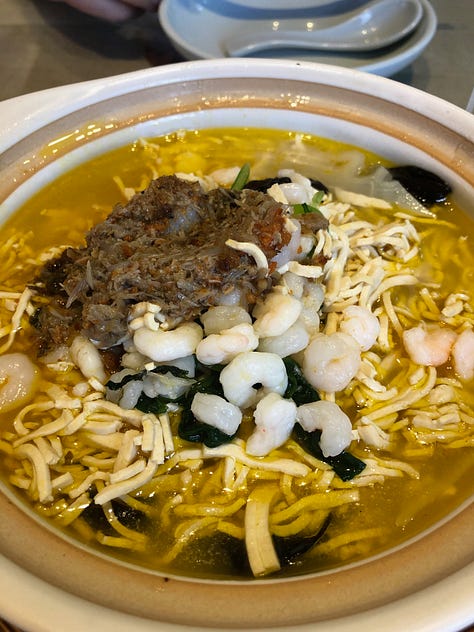



Representative dishes:
Lion’s Head Meatball (狮子头). Top left. An impressively large, tender meatball braised on the manner of hours. An old school banquet dish that practically defines Huaiyang cuisine, it can be served in stock (‘white soup’), or a soy sauce-seasoned stock (‘red soup’).
Yangzhou-style Dim Sum (扬州早茶). Top center. The progenitor of the now-world-famous Cantonese Dim Sum. Cantonese Dim Sum differs in that it tends to be heavier on meat and (especially seafood), while Yangzhou style Dim Sum features more starch and tofu heavy snacks. Pictured is a particularly iconic Yangzhou Dim Sum dish - ‘Crab Egg Soup Bao’ (蟹黄汤包) - that’s loaded with so much soup that the broth is drank with a straw.
Dazhu Gansi (大煮干丝). Top right. A traditional Huaiyang banquet dish that thinly, thinly slices dougan tofu (i.e. super firm ‘tofu jerky’) into a noodle-esque form, then cooks them through in stock. Commonly topped with shredded chicken, shrimp, and ham strips.
Choudayuan (臭大圆). Bottom left. An example of the more humble tucai - a braise of stinky tofu and intestine that’s somewhat spicy and designed to be devoured alongside white rice.
Braised Old Goose (红烧老鹅). Bottom center. Another good example of tucai. Goose is a common poultry in Jiangsu, and this dish selects old goose - which will be tougher, leaner, and more intensely flavored - and braises it for over an hour.
Xuecai Pork (雪菜肉丝). Bottom right. What Yacai is to Sichuan, Xuecai is to Zhejiang and (especially) Jiangsu. An extremely common pickle, this mustard green is commonly stir fried together with pork. An incredibly common homecooking dish, this stir fry can be eaten straight alongside rice, or it can also form the basis of a noodle soup.
Nanjing






Representative dishes:
Nanjing roast duck (南京烤鸭). Top left. The ‘original’ that inspired both Cantonese style roast duck in the south, and Peking Duck in the North. Employs a similar method as both, with a similarly lengthy marination time. Pictured is the duck served drenched in the drippings from roasting.
Salt poached duck (盐水鸭). Top center. Ubiquitous in Nanjing restaurants and home kitchens, salt poached duck is an old technique that first dry brines for at least two days, then poaches in water.
Duck blood noodles (鸭血粉丝汤). Top right. An incredibly iconic Nanjing dish that you can find in the dedicated duck-blood-noodle joints that dot the city. A snack or a quick meal, the soup consists of glass noodles served amongst coagulated duck blood and duck organ, all in a duck-stock-based soup.
Stuffed duck (八宝鸭). Bottom left. A fancy banquet dish that’s made from a fully deboned duck, and stuffed with sticky rice, lotus seed, Jinhua ham, and dried shiitake. It’s then poached, deep fried, steamed with sauce, and cut open at the table.
Nanjing Crawfish (小龙虾). Bottom center. Nanjing sits in an area renowned for crawfish production. As such, in the city you can find various crawfish joints, which are particularly popular in the summer. The crawfish are cooked by first deep frying, then stir frying in a flavorful sauce — pictured is a (mostly devoured) garlic sauce flavor, together with a spicy ‘13-spice’ flavor.
Candied Osmanthus Flower and Taro (桂花糖芋苗). Bottom right. A classic Nanjing dessert that leans on candied osmanthus flower, an ingredient also well used in Yangzhou style Dim Sum. This dish consists of taro cut into balls and cooked in slightly alkaline water, then made into a sweet soup with sugar and candied osmanthus flower.
Suzhou-Wuxi
Representative dishes:



‘Big Meat’ Noodles (大肉面). Left. The ‘big meat’ in the name referring to pork, this noodle soup consists of a big slab of braised pork belly in an eel stock, seasoned with actively fermenting jiuniang rice.
Cherry Pork (樱桃肉). Center. An old, sweet and savory banquet dish, Cherry Pork is a large hunk of pork belly braised in hongzao rice wine less, rock sugar and Shaoxing wine.
Wuxi Hot and Sour (酸辣汤). Right. Perhaps the origin of Chinese hot and sour soup, the Wuxi style leans on beef stock together with the area’s famed Zhenjiang (“Chinkiang”) vinegar. Wheat gluten puffs are a classic topping, and the thick soup is often eaten alongside yulanbing (玉兰饼) a meatball stuffed 'dumpling’ made using a sticky rice skin.
Jiangsu North



Representative dishes:
Diguo Chicken (地锅鸡). Top left. Diguo chicken is a simple braise at its core, cooked in a base of soy sauce and sweet bean paste. What’s special is that it’s then covered with ‘bing’ - a thin dumpling-skin-like dough - partway through cooking, before being finished with chili, garlic, and vinegar.
Sazi Rolls (撒子卷煎饼). Top center. These jianbing pancakes are at their base the Shandong style — i.e., a pancake made from wheat flour (unlike the Tianjin style, which are made with mungbean). Inside is wrap of crispy deep fried noodles called ‘sazi’, which gives the dish its name. A classic street snack, various sauces and Chinese leek are also often added inside.
Xuzhou Spicy Soup (徐州辣汤). Top right. Much like the ‘Hot Pepper Soup’ from Henan (which we’ll discuss below), the ‘spicy’ here doesn’t refer to chili, but rather the mild kick from peppercorns. Similar to the Henan classic, the viscous soup contains wheat gluten and thickens with the wheat starch (the by-product of gluten production). Differs in that Xuzhou Spicy Soup uses chicken stock as the base liquid, adds egg drop, and uses black pepper in place of white.
Shanghai






Representative dishes:
Pan Fried Bao (生煎). Top left. While Pan Fried Bao are a popular item throughout Jiangsu and Zhejiang, they’re famously beloved here — what the New York Slice is to the Five Boroughs, Pan Fried Bao is to Shanghai. There’s different styles to be found - some contain soup, some don’t - but the critical constant is the shatteringly crispy fried bottom.
Fantuan (粢饭团). Top center. Pictured is a ball of sticky rice filled with, well, stuff. Sweet and savory, the Shanghai sort always contains deep fried youtiao crullers, but you can find various fantuan breakfast rice balls up and down the eastern coast (and even into Taiwan).
Hot Meat Noodles (辣肉面). Top right. A noodle topping unique to Shanghai, ‘hot meat’ first shallow fries lean pork, then adds some sort of chili sauce to the oil — chili garlic sauce, Sichuan Pixian chili bean paste, a local chili sauce called jianghujiang (辣糊酱), dealers choice — before seasoning with a generous quantity of granulated sugar.
Shanghai-style Bakeries (面包房). Bottom left. Perhaps the most obvious culinary imprint of Shanghai’s colonial past, these bakeries were classically offshoots to the old ‘Haipai’ western restaurants below. A Shanghai cultural institution that serves up old school Western baked goods such as cornets, palmier, and buttercream cake.
Haipai Western (海派西餐). Bottom center. Back in the Treaty Port days, Haipai Western restaurants were fancy black-tie affairs that fed the city’s upper crust - both colonial, and local. Being less democratized than Hong Kong’s westernized Cha Chaan Teng tradition, when compared to their sister to the south it was less influential to the city’s cuisine writ large. Nevertheless, often staffed by Russian chefs, these restaurants were the progenitors of the Borscht-adjacent ‘Russian Soup’, together with bringing schnitzel into the Shanghai cultural consciousness.
Schnitzel with Rice Cakes (排骨年糕). Bottom right. A homecooking classic in Shanghai, derived from the Haipai western tradition above. This variant serves deep fries schnitzel on top of rice cakes cooked in soy sauce, five spice, and (optionally) Worcestershire sauce.
Anhui


Of The Big Eight, Anhui cuisine is likely the least well known outside of China. And perhaps that’s for a reason - few international travelers to the famed Huangshan mountain would list the local cuisine as the highlight of their trip. When I first went to the area as a teenager, I sure didn’t.
First, the province is most famed for its tofu - an ingredient that, even today, is still somewhat controversial in the west outside of food lovers and vegetarians. But perhaps more damningly, it’s renowned for it’s fermented tofu - tofus of the hairy and stinky variety.
To really appreciate Anhui cuisine, I think, you must first make peace with the funk. While in the 21st century westerners have increasingly made peace with the flavors of sour and spicy, ‘funk’ appears to be the final frontier for many. If you’re the type that can’t fathom why anyone could possibly enjoy stinky tofu, my best advice is to start within your own cuisine:
Wherever you live, find a cheese room. Get a variety of funky cheeses made from raw milk, and start there. Frankly speaking, many fermented products - whether they be wine, beer, strong cheeses, stinky tofus - aren’t often love at first taste. The reason why they’re beloved is that the flavor is interesting. It’s layered, it’s complex. Say what you will about a Belgian Sour or a Roquefort or a Stinky Tofu — you cannot say that they’re boring.
If you find yourself in Anhui and you’re not quite there yet? Understandable. Give it a go. And I’m sure there’s a Sichuan restaurant around somewhere…
In the province, most well known for their tofu is Anhui South. As you get to Central and North Anhui, the food starts getting saltier and bearing a closer resemblance to Henan to the North. In the mountainous bit in the west, there is a pocket called Lu’an that was difficult to categorize as exactly one or the other.
Anhui South



Representative dishes:
Hairy tofu (毛豆腐). Left. A type of fermented tofu, the ‘hair’ comes from mucor. But deeper in fragrance and flavor than un-aged tofu, but not as stinky as stinky tofu. Hairy tofu can be braised or panfried.
Fermented Vegetable Braised Tofu (千里飘香). Center. The titular fermented mustard green is referred in Anhui to as ‘mushy pickle’ (烂腌菜). Somewhat stinky, it can be braised together with tofu, and eaten with white rice.
Yi Pin Guo (一品锅). Right. A classic Anhui banquet dish and a winter specialty. Yi Pin Guo must contain pork, layered with egg dumplings. Other additions common additions are meatballs and hard boiled eggs — pictured is a pot that also contains shrimp and daikon.
Lu’an



Representative dishes:
Lu’an Hanging Pots (吊锅). Left. Originally a pot dangled for the purpose of eating over firepit, now the dish is more ‘flamboyant local novelty’ consumed in a restaurant setting. This particular pot is a braised goose with simmered in chili together with coagulated goose blood.
Stinky Tofu Guoba (臭豆腐锅巴). Center. Deep fried puffed rice dipped in a stinky tofu-based sauce.
Soft Baozi (软包子). Right. Thin skinned baozi called ‘soft’ due to their droopy appearance. They can be seen steamed or deep fried, and are often enjoyed next to a thick egg drop soup called ‘shatang’ (砂汤).
Anhui North (and Anhui Central)




Representative dishes:
Zajiang Edamame (毛豆杂酱). Top left. Anhui’s ‘zajiang’ leans on a local fermented broad bean paste called candoujiang (蚕豆酱). Stir fried with edamame and small local shrimps, this sauce is quite salty and excellent to chase with beer or liquor.
Xianmo (阜阳地锅咸馍). Top right. A filling, hearty breakfast, these thin pancakes are half-steamed, half-baked, and stuffed with vegetables like cabbage and carrot, and, at times, lemon basil.
Lamb Noodles (太和羊肉板面). Bottom left. A noodle soup famous to Taihe in Northwest Anhui. Made by frying chilis in a spiced rendered lamb fat, followed frying bits of lamb in the same concoction. This topping is then ladled over stock, and served with wide, fresh noodles.
Rooster Pot (老公鸡). Bottom right. Can be seen in pockets around China, but particular popular in North Anhui and Jiangsu. This pot uses old rooster (not hen) — the rooster is fried until browned, then braised with aromatics, soy sauce and wine.
Henan


Henan is the epicenter of Zhongyuan, the Central China Plain - a region most classically defined by the province itself, but an extensive definition would also include the North of Anhui and Jiangsu, the eastern portion of Shandong, the Hebei and Shanxi provinces to the North, and even into Shaanxi (Xi’an) to the west. This area was the cradle of Chinese civilization — it was the birth place of Lao Tzu, the power base of Cao Cao. It was where Pyromancers carved the very first Chinese characters into oxbone.
So in a lot of ways, it’s surprising that Henan cuisine doesn’t seem to have too powerful of a reach. And they’ve got some tasty dishes there, too — the hot pepper soup is particularly fantastic. If I had to pontificate a reason, I’d guess that it’s something core to the very name Zhongyuan - i.e., the plains.
If there’s one rule of thumb that this whole exercise of classifying Chinese cuisines has cemented in my head, it’s this - the flatlands connect, the mountains divide. Chinese food culture follows migration patterns and it follows trade networks. Both crash up against mountainous regions like water against a rocky coast, leaving little pools and pockets that end up developing differently than the lowlands from whence they came.
But the plains connect, and the central plain is a big plain. And so, sometimes when we gaze northward from the perspective of mountainous south, there can sometimes be a sort of… mish-mash effect. Henan, Shandong, Hebei, and Shanxi can can all sort of blend together as “Northern food”.
As people that penned a map differentiating Hakka from Dong River Hakka, that lumping certainly isn’t fair. There’s obviously regionality here. There’s even regionality within Henan - certain Henan chefs are quick to delineate a ‘Luoyang school’ and a ‘Kaifeng school’ of Henan food. The differences for us at this point are sort of difficult to parse (we have a lot of traveling in the North in front of us still), so we did the lazy default, and drew our lines at the province border.



Representative dishes:
Huimian (烩面). Left. Seen both at noodle shops and in home kitchens, these are quickly braised noodles cooked in stock, then topped with whatever meat said stock is made out of. There’s many varieties in Henan — lamb and beef huimian are two classics, but there’s also huimian in a curry soup, and Kaifeng has a unique creamy style made with sesame paste (尉氏烩面).
Hot Pepper Soup (胡辣汤). Center. A Henan breakfast classic with many variants. The key is washing wheat dough to separate starch and gluten — the starch is used to thicken beef or lamb stock, with the gluten is torn into pieces and added to the soup. Hot Pepper Soup often also contains wood ear fungus, day lily, meat from the stock, and sweet potato noodles.
Zhuangmo (壮馍). Right. The ‘Zhuang’ in zhuangmo likely meaning “strong”, this massive stuffed bread is fried until crisp. A street food classic with various fillings: donkey, pork, beef, lamb, egg, Chinese chives, and/or sweet potato noodle sheets. The pictured mo will set you back 60 RMB ($8 USD).
Shanxi


Still, what undeniably ties together all of these Northern ‘Zhongyuan’ cuisines is dominance of wheat flour as the staple grain.
In the south of Shaanxi (not Shanxi), there’s a mountain range called the Qinling Range. Geographically, it’s the divide between the Yellow river and Yangtze river systems. Culturally, it’s often thought of as the divide between North China and South China. And culinarily, people sometimes think of it as a marker of China’s wheat-rice divide.
At times, I feel people overstate the case of the wheat-rice divide in China. After all, southerners started eating noodles well before the 20th century. Northerners certainly also eat rice. Like, think about your own country - today, would you call it ‘wheat eating’ or ‘rice eating’? Being someone from America, I feel like the only proper answer there is “…yes?”
But still, these traditional staples do matter, because I think they illuminate the spread of the technology of dough making, and the boundaries of that spread. And I do say the word ‘technology’ there quite deliberately. As explained by /u/Iphikrates in their excellent discussion on why Gaming ‘Tech Trees’ are ahistorical:
To put it simply, technology is practice. It does not emerge or exist outside of its practical application within a society, economy, or culture. It is not pursued or preserved for its own sake. It has no intrinsic value. A given technology either has a use (in which case it may be developed and passed on) or it doesn't.
Writing is a good example. The Mycenaean Greeks of the Late Bronze Age had a syllabic writing system (Linear B), which we can read. They seem to have used it primarily to keep administrative records: palace inventories, letters between governing officials, and so on. But when the palaces burned and the administrative structures that ruled from them disappeared, writing went with them.
In Guangdong as it is in much of the West, noodle and dough making is something confined to the specialist. But in Shanxi, it’s part of the very definition of what a good homecook is.
A number of years back now, me and a few friends and coworkers in Shenzhen were having a small Chinese New Year get-together - a smattering of people that weren’t going back to celebrate in their hometown for one reason or another. Mostly an excuse to drink beer, we also grabbed a couple packs of dumpling skins from the supermarket and half-heartedly did the whole dumpling-wrapping-and-cooking tradition for a bit of fun. We had a new coworker from the North — Shanxi, specifically — who wanted to invite her mother as well. As an American in my mid 20s that was a couple beers in already, I wasn’t super thrilled about the prospect… but she insisted: “she makes really good dumplings!”.
I’ve always been an easy person to convince.
I’ll never forget the look on her face when she came in and saw the slop of our dumplings. Just… sheer disgust on a Kipling-esque level. She quickly took over the project, and made some memorably delicious dumplings.



Representative dishes:
Kaolaolao (栲栳栳). Left. Quite famous Shanxi noodle dish whose reach extends into neighboring Shaanxi. A hot water dough made from naked oat (莜面), the noodles are shaped into small sheets and rolled around a finger to arrive at the characteristic shape. Steamed, then eaten with a tomato and egg (or alternatively pork and potato) dipping sauce.
Knife Cut Noodles (刀削面). Center. Originally a Datong city specialty. The hydration of the dough pushes the boundaries of ‘low hydration’ - shops use a special knife and slice the dough straight into boiling water; home cooks usually use a gadget that looks almost like a vegetable peeler. Most classically topped with a diced pork topping called sao (臊), but other toppings include tomato and egg, fresh chili and pork, or braised beef.
Stone Baked Flatbread (石子馍). Right. A flatbread baked by burying dough in scalding hot, quail-egg-sized stones. Shapes differ, but in Shanxi (unlike its Shaanxi cousins) the bread is usually stuffed with sweet fillings such as brown sugar, mung beans, red adzuki beans, or red date paste.
Shandong

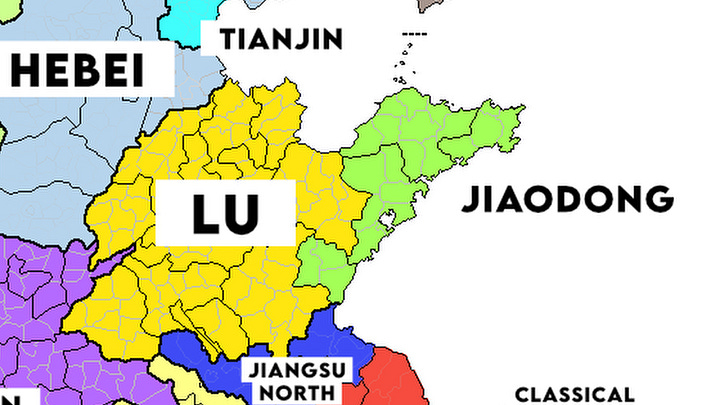
As we discussed in the introduction, The Big Eight was actually an extension of the big four banquet traditions of the country. We could probably, if needed, halve the list again — most, if not all, Chinese banquet traditions are derived from two cuisines: Huaiyang, which we discussed in the Jiangsu section, and Lu - classical Shandong cuisine.
You could perhaps think of the difference between these two Haute cuisines as akin to the difference between French and Italian. Whatever stuffy heights the cuisine ends up reaching… Huaiyang, like Italian, is ultimately a system that’s bottom-up. The fine dining system has a connection to the land and the people — the food leans on whatever produce is local and high quality, the dishes are inspired by the food the common people actually eat.
Lu, by contrast, has a top-down energy that would make Escoffier proud.
The food world nowadays tends to celebrate the former: the fine dining world is quick to advertise its bottom-up chops. There’s something that feels real and natural about the Huaiyang and Italian approach - an ethos that, for example, was very much copy-pasted by Alice Waters to create what we now know of as California Cuisine.
Bottom-up has become so celebrated in modern times, that perhaps top-down is becoming somewhat underrated.
After all, Lu cuisine was the first cuisine to really systematize stocks and sauces in China. It standardized kitchen organization; it created what we think of as the wok station. It crafted naming conventions, changing the very language of how people talk and think about food. If the Henan province is the cradle of Chinese civilization, Shandong is the cradle of Chinese culinary civilization.
It’s difficult to recreate the flavors of the Italian coast without the Italian coast. French and Lu, by contrast, are portable ideas. There’s a reason why the Russian Czars opted for French chefs, and the Forbidden City leaned on Shandong.
But of course, that was the food of the elite. Shandong itself has a ton of fascinating pockets that we really need to get to. Boshan is an intriguing pocket and reportedly the origin of my all time favorite eggplant dish. Zaozhuang has their own version of Spicy Chicken (辣子鸡), and the whole province has this ineffable Sichuan connection that sort of hurts my brain. Sometimes random shit from Shandong suddenly bursts onto the scene in China, seemingly without warning: Dezhou chicken became a Beijing-Shanghai train ride tradition, and these days Zibo barbecue is starting to become increasingly popular (it’s basically standard Chinese BBQ, albeit eaten alongside Spring Pancakes ala Peking Duck). And of course, the whole area around the coast, Jiaodong, is totally different.
Lu





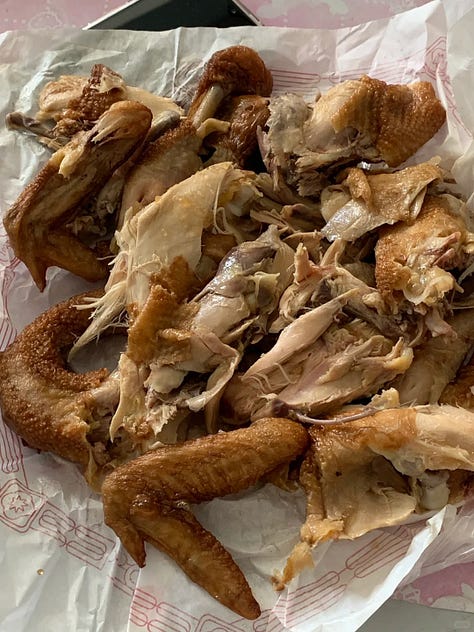
Representative dishes:
Nine Twist Intestine (九转大肠). Top left. A classic banquet dish practically synonymous with Lu cuisine. ‘Nine twist’ refers to a cooking technique that’s delicate and complicated (not that the intestine is twisted nine times, as is commonly misunderstood). A shockingly complex dish that we will never, ever cook on our channel… the dish features seven cooking stages: washing (洗), blanching (汆), simmering until soft (煮), frying (煸), braising in sauce (煸), braising over a very low flame (煨), and thickening (㸆). Completing our tour of the aesthetically pleasing odd numbers, it’s also supposed to hit all of the ‘five tastes’ (sour, sweet, bitter, spicy, and savory).
Sweet and Sour Carp (糖醋鲤鱼). Top center. Another classical Lu dish often seen at banquets, and… another absurdly technique-heavy dish. Famously requiring some impressively exquisite knife skills to shape the damn thing, once the fish is cut it’s then battered and deep fried. The fish must be continuously shaped while frying in order for it to be able to ‘stand’ — finally finishing with a sweet and sour sauce to plate.
Pucai in Milky Stock (奶汤蒲菜). Top right. A banquet dish of bulrush, it first blanches before cooking with ham, shiitake, and dried shrimp in a milky stock. Thickened, interestingly, with what could be called a roux by any other name — vegetable oil mixed with wheat flour.
Chinese Leek Jianbing (大葱煎饼). Bottom left. Originating in Yimeng mountain area, this Jianbing (“Chinese Crepe”) variant is made from a mix of grains - corn, sorghum, millet, and wheat. While you can use these Jianbing to roll up pretty much anything, most classic is to fill it up with brushing soybean paste and a hunk of Chinese Leek.
Cantonese Meat (广东肉). Bottom center. Apocryphally, this oddly named dish was borne when a Qing dynasty merchant tried tried a western-style pork chop during his travels in Guangdong. Returning to Shandong, he instructed his personal chef to replicate the dish. And while perhaps something was lost in this cross-cultural game of culinary telephone, this soy sauce and five spice-forward fried pork chop can be found throughout Shandong today.
Dezhou Tender Chicken (德州扒鸡). Bottom right. Braised chicken is a traditional dish from Dezhou, and is also known as "Dezhou Five-fragrant Boneless Braised Chicken" — developed by the Deshunzhai (德顺斋) Restaurant in Dezhou. Deep fried and braised until tender, famously sold at train stations to travelers on the Beijing-Shanghai route.
Jiaodong


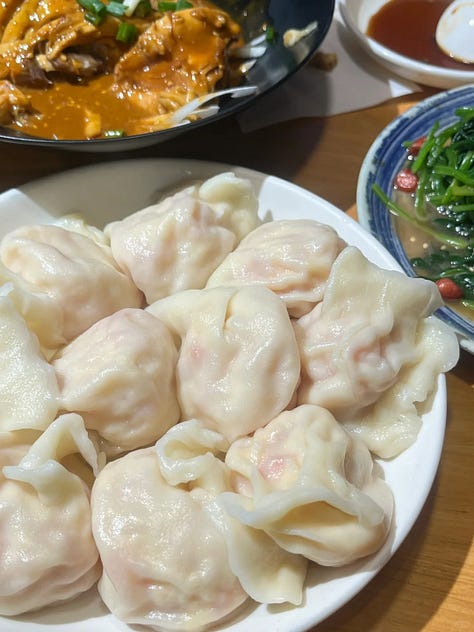
Representative dishes:
Scallion Braised Sea Cucumber (葱烧海参). Left. Another famous Shandong banquet dish. Reconstituting dried sea cucumber is a cumbersome 2-3 day process in and of itself - it’s then steamed in Shandong consommé, shallow fried in scallion oil, then finally braised in a sauce made from scallion and consommé.
Penis Fish (海肠). Center. A seafood that’s abundant in the area, sporting a name that mades the 13 year old in me giggle. Pictured is the (somewhat accurately named) fish sliced up and stir fried with Chinese chives; grilling at Chinese barbecue is another popular choice.
Seafood Dumpling (鲅鱼水饺). Right. The area’s seafood dumplings lean on a type of mackerel beloved in the region. The fish is deboned and pound into a paste before being mixed with pork, Chinese chives, and stuffed in a dumpling.
Hebei


Hebei province, culinarily, is a place sometimes… a bit slagged on by the rest of the country. Back in my early days in China when I lived in Beijing, I vividly remember a friend of mine saying with a smile that “Hebei is the English Food of China”.
Now, I should say upfront that I’m not a fan of the whole ‘lol british food sucks’ trope. If you were ranking the different cuisines of all of North Europe, would British food really sit at rock bottom? Tastes differ, but I’d imagine probably not! British food has the reputation it does because of where it sits geographically — right there next to France.
Proud culinary traditions have a way of slagging on their next door neighbors. France slags on England, England internalizes the diss track. Cantonese often like to slag on Teochew and Fujian. And Beijing and Tianjin seem to have a similar relationship with Hebei.
But like, look at that map again - there’s a certain oddness to a province that has what would be its two largest metro areas ripped out as administrative enclaves, no? Would French food have the same reputation if we separated it from Grand Paris and Provence?
I don’t have too many answers. I’ve myself only ever stopped off in Shijiazhuang briefly, many years back. But I seem to remember eating well enough.



Representative dishes:
Braised Donkey Sandwich (驴肉火烧). Left. Donkey meat slowly braised in stock and spices, served up in a crispy unleavened flatbread called huoshao. Comes in round form (Baoding style, pictured) and rectanglar (Hejian style).
Lionfish (狮子鱼). Center. A banquet dish that slices carp (not lionfish) into more than two hundred thin sticks before deep frying and smothering in a tomato-based sweet and sour.
Baozi (包子). Right. Admittedly scraping a bit here, as Baozi and Dumplings can obviously be found well throughout China. That said, they’re quite good in Hebei (together with Beijing and Tianjing). In Shijiazhuang, the Red Star Restaurant is quite famous for their Baozi.
Tianjin


Whether it be Tianjin or Beijing, the two Hebei-nestled urban enclaves have an imprint of the aforementioned Shandong culinary system that you don’t necessarily see in rural Hebei. For example, the Tianjin’s ‘Four Happy Meatballs’ (top left, below) is quite obviously influenced by this classical tradition. Further, just like neighboring Beijing, this classical traditional also blends and mixes with some Chinese-Muslim influences (e.g. braised beef strips, top center).
But within this cauldron of Shandong, Hebei, Beijing, and Tianjin… there’s still undeniably some regionality. A decent example might be the case of Sichuan pepper oil. Within the traditional Shandong system, Sichuan pepper oil is used rather judiciously, mostly to counter certain unpleasant odors. In Beijing, the usage is dialed up, appearing as a dipping sauce and as a topping for noodles. Tianjin goes even further - practically all dishes make use of Sichuan pepper oil to some extent, employing a special local variant that also includes toasted sesame in the mix.
Tianjin is also unique among the four in its western influence - it was among the treaty ports, after all. While their Chinese-Western tradition may not be as famous as Hong Kong’s, Shanghai’s, or Harbin’s… it’s undeniably there, bringing some delightfully weird concoctions such as their category of ‘white sauce’ dishes.
(Oh, and Tianjin people would kill me if I didn’t mention that they were the progenitor of the Jianbing pancake).






Representative dishes:
Four Happy Meatballs (四喜丸子). Top left. A festival dish and a banquet dish. The meatballs themselves are generally a mix of pork, water chestnut, Tianjin ham, wood ear, bread crumbs, egg, and starch (sometimes even appearing stuffed with hard boiled egg). They’re first deep fried, before steaming in a soy sauce based sauce.
Braised beef strips (扒牛肉条). Top center. A classic Tianjin Halal dish that cuts blanched beef into thick strips before frying and steaming with sesame oil, sweet bean paste, and beef stock.
Jianbing (煎饼果子). Top right. The very most famous Tianjin street food, and a topic that Tianjin people themselves are incredibly opinionated about. Made with a batter of mungbean, corn, and wheat, the Tianjin style also layers in a crispy deep fried dough sheet called guobie (果蓖). Youtiao is another valid choice.
Tangyou Guozi (糖油果子). Bottom left. A breakfast classic. Consisting of layers of plain dough and brown sugar dough, the thing’s deep-fried in its impressively-size entirety until crispy before chopping into small pieces to sell (often by weight).
Curry Pulled Noodles (黄汤拉面). Bottom center. Allegedly inspired by Lanzhou beef noodle soup (below), this Tianjin variant contains a number of similar ideas, but adds curry sauce to the mix.
White sauce dishes (奶爆三样). Bottom right. An old school banquet approach, these dishes consist of a protein passed through oil, and then stir frying in a sauce made from with milk (or evaporated milk). Finished with a slurry, fresh minced garlic and Sichuan peppercorn oil, an even fancier version is “White sauce everything” (奶汁全爆), which does all of the above using eight separate ingredients.
Beijing


Beijing food, historically speaking, could sort of be thought of in a similar fashion as Huaiyang: there was the food of the elite, together with a more humble cuisine sitting beside it. The latter had a good bit of crossover with Hebei (although I suppose I shouldn’t say that too loud, lest the Bejiing people might overhear me).
The food of the elite, however, could be thought of as a blend of three traditions - Huaiyang, Shandong, and… Guanfucai.
Guanfucai is a historical Chinese cuisine which developed during the Ming and Qing dynasties. Sometimes thought of as the Haute cuisine of China, I think the literal character-by-character translation actually tells a more complete story: “government official cuisine”.
You see, Imperial China, administratively, had long traditions of (1) the rule of avoidance (回避制度), prohibiting local officials from serving where they came from and (2) rotating said bureaucrats between localities — practices that continue to this day. Nice way to centralize the state, avoiding the buildup of competing local power structures. In practice, what this created was a separate, trans-provincial, scholar-official class: the “Mandarins”.
As to what they ate, I like to think of it sort of akin to the fare served up in Michelin guide, or maybe ‘Asia’s Top 50’. From Zen in Singapore, to Hélène Darroze in London, to Le Du in Bangkok, to Florilège in Tokyo, to Le Bernardin in New York… there’s a certain sameness to it all. I think of it as the food of our trans-national scholar-capitalist class — the New Mandarins. I call it “Davos cuisine”. It’s a cuisine not without merit, and definitely not without craft. Just a different flavor of bread.
And what New York and London are today to Davos Cuisine, Beijing was to Guanfu Cuisine. It was the nexus, the gathering point. And just like how Davos Cuisine is layered on with the elite traditions of France and Japan, the food in Beijing was also layered on with the banquet traditions of Huaiyang and Shandong. They grabbed sauces and stocks from the latter, and the former… I mean, the famed Peking Duck is nothing if not a Nanjing-Northern fusion.
These days, there’s a blending — it’s not overly easy to tell where general Northern/Hebei stops and classical Beijing begins. Modern Beijing is also a big city, filled with migrants from elsewhere - the new ‘national cuisine’ of Sichuan is well represented, ditto with the food from the Northeast. Even the trans-national scholar-capitalist class is not without their canteens.
But besides the must of Peking Duck, if there’s one thing I can recommend to international travelers to Beijing… it’s the city’s Zhujingban (驻京办). These are old-style, government-run restaurants that dedicate themselves to a cuisine of a single province. Though they might not be completely representative, the food quality is generally very good. An echo, in a way, of the tradition of gathering cuisines from around the country. If you’re in Beijing, curious about what Hubei food is like, but have no time to travel to Hubei… the Hubei Zhujingban (“Hubei Restaurant”) wouldn’t be a bad bet.


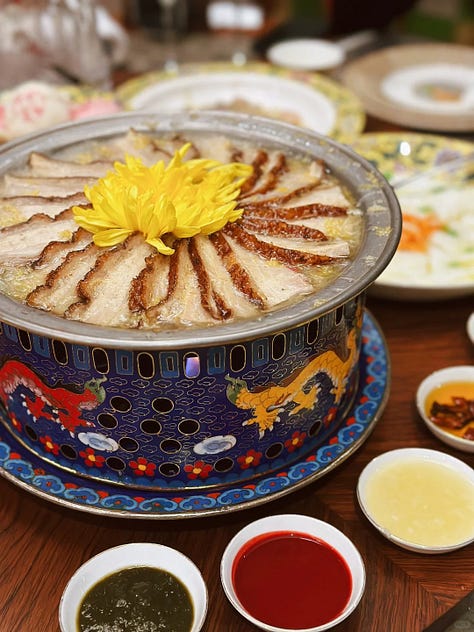
Representative dishes:
Peking Duck (北京烤鸭). Left. The icon. Crispy roast duck wrapped in Spring pancake, smothered with a sauce consisting of equal parts sugar and sweet bean paste. A dish well loved by pretty much everyone that’s ever laid their hands on it.
Naibobo (奶饽饽). Center. Milk set with fermented rice wine to create a sort of ‘cheese’. This is then slightly pressed and stuffed with Hawthorn fruit jam.
Imperial Hotpot (宫廷火锅). Right. More of a category than a ‘dish’ per se, Imperial Hotpot refers to hotpots derived from the tradition as practiced in the Qing dynasty, where it was historically well loved by the Mandarin people. It was allegedly Emperor Qianlong’s favorite dish — an idea well backed by when more than 200 hotpot meals were made in one year (1789) according to the Qing imperial court registry. Imperial hotpot has many varieties, from pork belly with fermented cabbage, to lamb pot, chicken pot, mixed pot, blood sausage, etc etc.
Dongbei Region

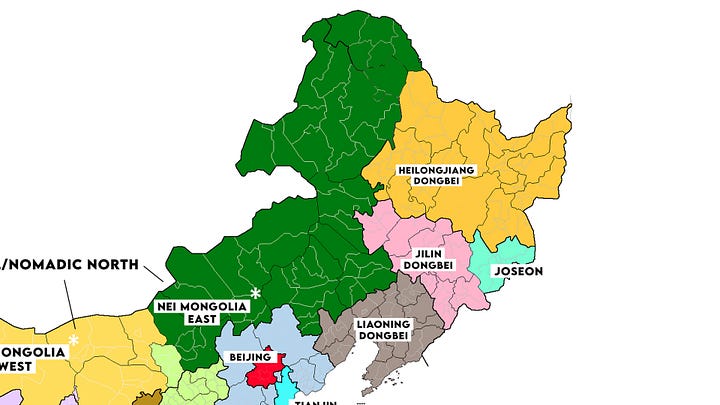
If you’re eating Dongbei - Northeastern - food outside of the region itself, it’s pretty much always going to be categorized as just that. And there is a sort of ‘general’ Northeastern food that’s threading through the whole area - lots of crossover on a dish by dish basis.
And yet, there is regionality. Jilin - around the city of Changchun - hues to my personal stereotype of ‘Northeastern’ food the closest, with their hearty stews and love of fermented cabbage.
But there’s also a Dongbei food of the coast as well - a swath north of the Bohai Sea which serves up seafood-laden fare as well. We were a little bit unsure where exactly to draw the line in Liaoning - while the city of Dalian is renowned for their seafood restaurants, Shenyang a bit less obvious of a location for a seafood feast. We (lazily, perhaps) defaulted to drawing the line at the province border.
Heilongjiang is very much within the nexus of ‘stereotypical Dongbei food’, but also blends this with a historical Russian influence. In Yanbian along the North Korean border, there is a large group of ethnic Koreans called the Joseon, which have Korean food similar to what is found in North Korea.
General Dongbei/Jilin Dongbei






Representative dishes:
Crispy Sweet and Sour Pork (锅包肉). Top left. An iconic Dongbei dish that can be found throughout all three provinces. Pork loin coated in a incredibly viscous, borderline non-newtonian starch coating and deep fried to create a tooth-shatteringly crunchy crust. Believed to have originated in Harbin, which tops with a simple, vinegar-based sweet and sour sauce.
Suancai Pork Belly (酸菜白肉). Top center. A winter favorite and a home cooking classic, this braise of fermented cabbage and skin-on pork belly can also double as a hotpot base as well. The meat can also be dunked in a soy sauce-vinegar-garlic-chili oil dip at the table.
Iron Pot Braises (铁锅炖). Top right. Traditionally a home cooking dish, it originally came from the practice of braising (often foraged) stuff in a big pot to create a sort of ‘one pot meal’. Only gaining the name ‘iron pot braise’ (铁锅炖) after it became commercialized, a popular move is to slap some cornbread or flatbread on the side to cook simultaneously, as pictured.
Di San Xian (地三鲜). Bottom left. Historically, ‘Di San Xian’ referred to a mix of tiger, bear, and deer. Given that those ingredients are difficult to find and most definitely illegal, Di San Xian now refers to a vegetarian mix of eggplant, green pepper, and potato.
Hu Bing (烀饼). Bottom center. Similar in concept to the Di Guo chicken in Jiangsu, these braises add dough to the top of the dish to steam while cooking.
Jiang Gu Jia (酱骨架). Bottom right. While this can be found in home kitchens as well, this is a Dongbei restaurant must-order. It consists of pig thigh bone blanched and red braised with the usual suspect plus (most importantly) Dongbei-style soy bean paste.
Liaoning Dongbei



Representative dishes:
Shrimp Paste Braised Squid (虾酱笔管). Left. Shrimp paste is a common ingredient in the area, as well as ‘shrimp oil’ (虾油, a fermented sauce similar in flavor to fish sauce). Often used as a base of a braise, tofu and egg are two other favorites.
Seaweed Pancake (海菜饼子). Center. A Dalian specialty — a corn pancake stuffed with wakame kelp (裙带菜) and, at times, meat or seafood.
Sanxian Menzi (三鲜焖子). Right. Menzi (焖子) refer to cakes made from sweet potato starch and cut into inch-sized cubes. A common ingredient in the north, this particular dish is made by frying the menzi, topping with minced garlic and sesame paste, then smothering it all with a saucy seafood stir fry.
Heilongjiang Dongbei



Representative dishes:
Harbin Kielbasa (哈尔滨红肠). Left. Basically a Kielbasa by any other name, brought over by Russians. A popular side dish to go along with a meal or beer, it can also be an ingredient — employed in stir fries, noodle soups, and fried rice. A home cooking classic it to stir fry it with potato and green pepper.
Harbin Old Bread (列巴). Center. Called lieba in Chinese, a transliteration of the Russian word “хлеб” — the bread is a ‘sourdough’ made from a levain containing beer hops.
Demoli Stewed Fish (得莫利炖鱼). Right. A rustic dish from a small village named Demoli north of Harbin, this is the sort of massive Dongbei pot that could likely feed an entire southern Chinese village. Featuring large, fresh water fish from the Songhua River, it fries the fish golden then braises with ginger, Chinese leek, Star Anise, Dongbei-style fermented soybean paste, tofu, and sweet potato noodle.
Joseon

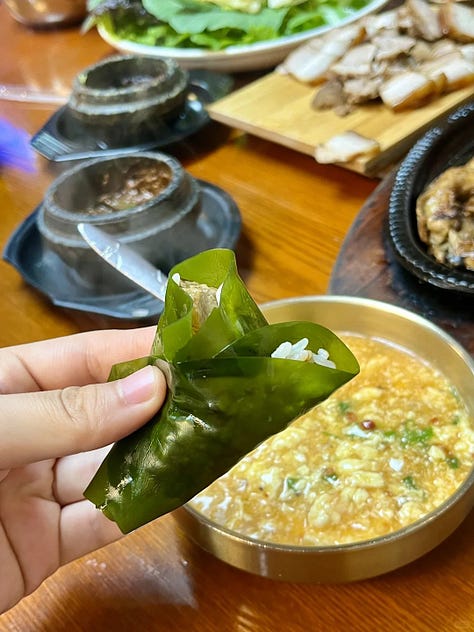

Representative dishes:
Kimchi (泡菜). Left. Where Korean people go, Kimchi tends to follow. In addition to (obviously) being a staple in the Joseon area of Yanbian, the rest of Dongbei has also started to develop a taste for the ingredient — commonly being employed as an appetizer.
Rice Wrap (包饭). Center. Another Joseon classic. These wraps hit that very ‘Korean’ feeling place of grilled meat, garlic, chili, kimchi, shrimp paste, and rice — all placed inside a bite sized pocket of lettuce. Pictured is the same idea with kelp in place of lettuce.
Ice Cold Noodles (冷面). Right. Similar to the Korean version you might already know and love, these are naked out noodles sitting in some ice-cold beef stock (that’s still got a bit of slush to it). Often topped with with beef slices, tomato, cucumber, kimchi, and hard boil egg.
Inner Mongolia


Inner Mongolia is awkward.
East to west, the province stretches to about the width of India. And while plains, indeed, connect… the sheer scope of the place intimidates. It’s also - much like outer Mongolia - incredibly sparsely populated.
And yet, there’s still some reasonably large cities: the capital Hohhot’s metro area is three million people large, and there’s a handful more that clock in at around the million mark (give or take). And ethnically, these urban areas are very much populated by Han Chinese.
But the steppe, i.e most of what we have to color in on that map? It’s extremely Mongolian, or at least nomadic. That’s the common thread running throughout this whole province, but what’s going on in the cities - where most of the human souls reside - should matter too for food, right?
In the capital of Hohhot, the fare feels to me extremely Shanxi - albeit Shanxi with maybe a bit of a nomadic accent. I feel there’s a bit more pronounced of a Mongolian influence elsewhere, but in the urban east it’s blending with Northeastern Chinese; in the urban west, Northwestern.



Representative dishes:
Lamb Shaomai (羊肉烧麦). Left. A day to day classic in Inner Mongolia, and might actually be the OG form of the dish known today as Siu Mai at Cantonese Dim Sum (the earliest known written record refers to this version). The one in Inner Mongolia consists of a thin wheat flour-based wrapper stuffed with diced lamb and Chinese leek.
Shoubarou (手把肉). Center. Commonly seen in the eastern grasslands around Hulunbuir, it doesn’t get much simpler than this. Lamb stewed in salted water, served together with a flowering garlic chive dipping sauce.
Ice Boiled Hotpot (冰煮羊). Right. Cooking lamb pieces directly with unmelted ice, this pot probably originated from the harsh nomadic steppe — a place where ice was often the best water source. It’s enduring popularity is not just a gimmick, as the meat functionally cooks slower and gentler than if you dunked it directly into a hot pot.
Northwest


The Chinese Northwest. Land of beef, mutton, bread and noodles.
I used to quip that if I had to choose one Chinese cuisine to sell Americans on, it would be this. If I ever had a friend that came to China and found themselves not into Chinese food for whatever reason, dragging them to a Northwestern restaurant was a surefire cure for that ailment.
The area is deeply influenced by the Hui people - a Chinese Muslim ethnoreligious group with a kind of… complicated ethnic identity. Most people’s first introduction to Northwest Hui is at the noodle chain “Lanzhou Lamian”, with some noodle masters vigorously slapping some delectable hand-pulled noodles for fast food-level prices.
As you move further and further into the far west, the food begins to get increasingly Central Asian in influence, until you arrive at Xinjiang which is practically a Northwest-Central Asian fusion. There’s a patchwork of ethnic groups that make up the Xinjiang province, but the two dominant groups are Han Xinjiang and Uighur Xinjiang. In a modern restaurant environment - and even in home kitchens - there’s a lot of crossover between the two, but their relative starting points are disparate enough that I think it still makes sense to refer to the two as distinct cuisines.
On the other end of the region, closing in towards the central plains - Shaanxi has the richest written culinary tradition in the swath and is quick to delineate its own regionality. Shaanxi central is based around the city of Xi’an, and is generally the type of food you would find in a general ‘Northwestern’ restaurant outside of the region. Shaanxi North is quite rugged, while also showing some nomadic influenced; Shaanxi South is sort of a mix between Sichuan and Xi’an food, though an argument could be made for lumping the area in with one of those two.
Northwest Han-Hui



Representative dishes:
Beef Noodle Soup (兰州牛肉面). Left. The legendary Lanzhou Lamian. A pulled alkaline noodle made soft with a special local ingredient called penghui (蓬灰). Always called ‘beef noodle soup’ in Lanzhou proper, the soup itself is a heavily spiced beef stock, topped with chili oil, daikon, and green garlic.
Niangpi (酿皮). Center. Niangpi consist of an alkaline wheat batter, steamed into cake, then cut into noodle form. Always doused in chili oil, pictured is one also topped with vinegar, garlic water, and yellow mustard.
Sweet Fermented Oat (甜醅子). Right. Similar in concept to the the coast’s Jiuniang, sweet fermented rice. Sweet fermented oat uses the same rhizopus forward blend of microbes, but applies it to oat instead.
Han Xinjiang


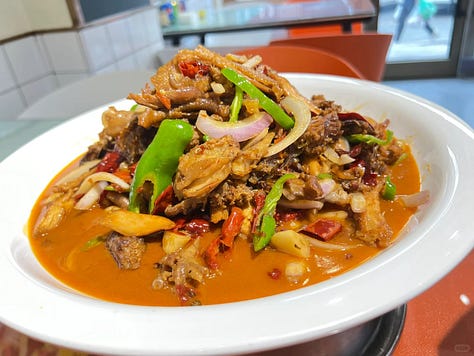
Big Plate Chicken (大盘鸡). Left. Legend has it that Big Plate Chicken came from Sichuan migrants to the region, this dish consists of chicken fried in a tangse caramel, then braised together with fragrant, mildly spicy Xinjiang chili (likely the same cultivar as Kashmiri, or at least closely related), tomato paste or Sichuan chili bean paste, and big hunks of potato. Served over wide, flat fresh noodles called kudaimian (裤带面).
Xinjiang Rice Noodles (新疆炒米粉). Center. Another dish at least apocryphally from migrants to the region (this time from Guizhou), Xinjiang rice noodles make use of the area’s famed rice, topping the noodles with Chinese celery and an incredibly spicy chili-tomato sauce.
Jiaoma Chicken (椒麻鸡). Right. A Xinjiang variant of a Sichuan dish. Poached chicken mixed with a spiced chili oil, Sichuan pepper oil, green pepper and onions, together with a bit of the poaching liquid.
Uighur Xinjiang



Polo (پولۇ/手抓饭). Left. A Uighur Pilaf cooked quite similarly to their Uzbek and Tajik neighbors. Polo often includes a mix of different carrot cultivars, and makes use of the area’s prized Xinjiang rice — a hearty, short-grain, bomba-like rice that’s essential to a good Polo (outside of Xinjiang, restaurants tend to opt for Dongbei rice, which’s never quite the same)
Samsa (سامسا/烤包子). Center. Referred to as ‘roast baozi’ in Chinese, Samsa are meat-stuffed savory pastries cooked in a Uighur style tandoor (تونۇر).
Naan (نان/馕饼). Right. An incredibly common sight throughout Xinjiang, Naan are flatbreads that consist of a soft, bread-like ring on the outside and a crisp, cracker-like interior.
Shaanxi Central



Representative dishes:
Liangpi (凉皮). Left. Similar to Henan’s Hot Pepper Soup, Liangpi are a dish deeply rooted in wheat gluten production. Liangpi, however, goes in a radically different direction — putting the washed starch as the centerpiece, steaming it into a cake, and cutting into noodles. Served with said gluten, the mix is then topped with chili oil, garlic water, and a spiced sauce.
Rou Jia Mo, a.k.a. ‘Chinese Hamburger’ (肉夹馍). Center. A sandwich of stewed pork - lazhirou (腊汁肉), apocryphally braised in a mix of 15 spices - stuffed in Chinese mo bread. Halal versions featuring lamb or beef are also quite common. Outside of Shaanxi, roujiamo can also be seen with other toppings cut into the mix such as chili oil, green mild chili, onion, and cilantro (additions that, while potentially tasty, would be seen as sacrilegious in Xi’an).
Biang Biang Noodles (BB面). Right. Wide, flat hand pulled noodles whose name is actually an onomatopoeia - ‘biang’ being the sound the noodle makes when slapped against the counter while pulling. Can have a variety of toppings, but in Xi’an the classic is usually sizzling chili oil and stewed tomato and egg. Stewed pork being another common addition, all three together are called sanheyi (三合一) — “three toppings in one”.
Shaanxi North



Representative dishes:
Shaanbei Big Braise (陕北大烩菜). Left. A rustic, festive dish, usually containing pork, green beans, tofu, vegetable, potato, and potato noodles.
Zichang Jianbing (子长煎饼). Center. A street food hailing from Zichang, this Jianbing is a thin wheat batter pancake wrapped with meat or tofu inside.
Potato Caca (洋芋擦擦). Right. A home cooking classic, likely deriving from substituting wheat noodles for potato as a necessity. Made by coating thinly sliced potato with flour and steaming — can be eaten straight, or stir fried (as pictured).
Shaanxi South
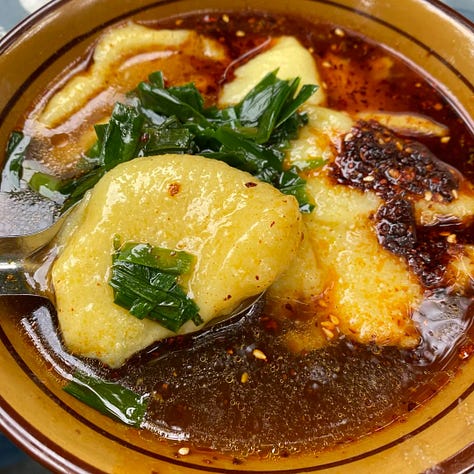
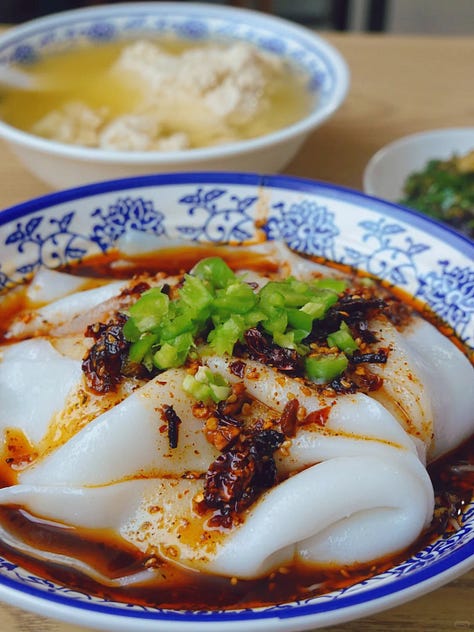

Representative dishes:
Potato Ciba (洋芋搅团). Left. Mashed waxy potatoes, but mashed so hard that the amylopectin inside makes the potato chewy. Often eaten with the local fermented sour soup, topped with chili oil and blanched Chinese chives.
Hot Mipi (热米皮). Center. Symbolic of the area’s Sichuan influence — a rice noodle sheet in a otherwise noodle country. Eaten hot with fragrant chili oil.
Mianpi ( 面皮). Right. Thinly rolled out wheat dough steamed, served hot or cut as pictured. Can be served mixed with chili oil or in a soup. Almost always includes soybean sprouts, and often eaten with vegetable tofu pudding (菜豆腐).
Outside of Mainland China
Hong Kong and Macau
Hong Kong Cantonese
Much like how we decided to separate Shanghai as distinct from Suzhou and Wuxi, we felt it was similarly appropriate to categorize Hong Kong as separate from the rest of Cantonese.
That’s not because people in Hong Kong don’t eat Cantonese food, of course. Hong Kong is Cantonese, but it’s a Cantonese with a bit of an accent. A cultural institution in Hong Kong is Cha Chaan Teng - Canto-western diners that left an indelible imprint on how Hong Kongers eat. Hong Kong-style milk tea might be the most obvious bit, but pineapple buns and breakfast macaroni soup wouldn’t be far behind.
Of course, post reform and opening, Hong Kong western cuisine came incredibly popular within mainland Cantonese areas as well. In our old home of Shunde, these days Hong Kong Cha Chaan Teng are almost as popular of a restaurant concept as the more classically Cantonese Dai Pai Dong. Steph herself also grew up with Macaroni Soup. In a generation it’s quite likely that the distinction between Hong Kong Cantonese and Mainland Cantonese will begin to melt away.
Of course, besides the western influence, Hong Kong certainly also developed its own unique local Cantonese dishes, and we’ve listed a few below. That said, it’s important to bear in mind that there’s similar regionality to be found within many cities, towns, and villages of the greater Pearl River Delta region.




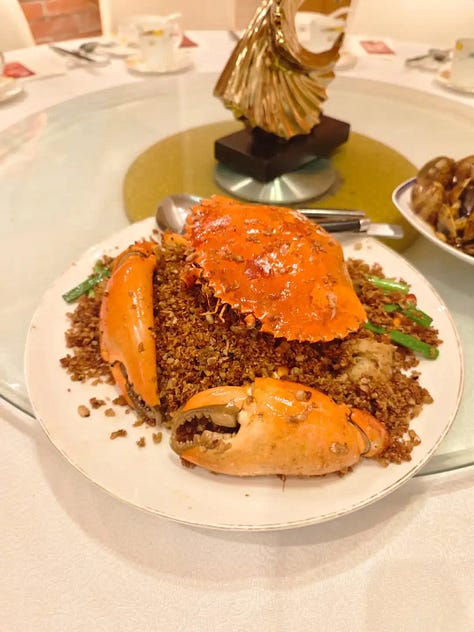
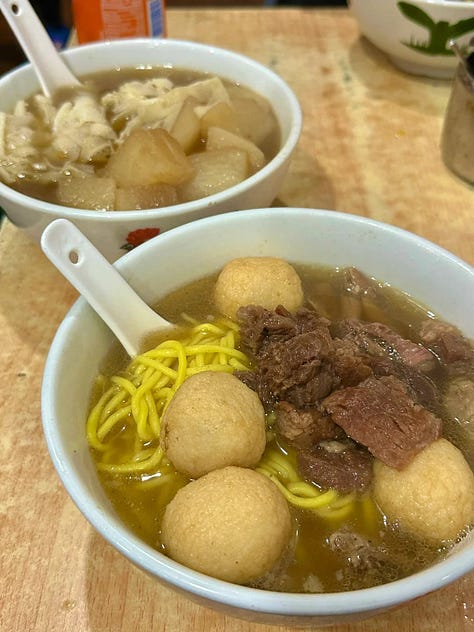
Representative dishes:
Macaroni Soup (火腿通粉). Top left. Cantonese tend to adore noodle soups, so maybe it’s no surprise that the historically popular European tradition of Macaroni soup lives on in Hong Kong. Can be served in a Cream of Chicken base, a tomato beef base, or a stock base with ham (pictured).
Pineapple Buns (菠萝包). Top middle. A chewy bun with a sugar cookie topping that may or may not be derived from Japanese Melonpan. The most classic in Hong Kong is a warm bun with a generous hunk of cool butter inside, pictured is one at a Cha Chaan Teng in spam sandwich form.
Hong Kong Milk Tea (港式奶茶). Top right. Hong Kong’s take on the British love of milk tea. A bit stronger, classically uses a mix of several types of tea leaves mixed with evaporated milk.
“Piggie” Cheong Fun (猪肠粉). Bottom left. A soft rice noodle roll traditionally made with short grain rice, and a general Cantonese classic. In Hong Kong, it developed into street food, topped with the famed ‘mixed sauce’ (混酱) of hoisin, sweet chili, and peanut butter.
Typhoon Shelter Dishes (避风塘炒蟹). Bottom middle. ‘Typhoon shelter’ dishes allegedly came from the Tanka eateries at the typhoon shelters, today it’s now a flavor profile of deep fried garlic, toasted bread crumb, dried shrimp, and (often) fermented soy bean. Typhoon shelter shrimp and Typhoon shelter crab are the most famous versions.
Cart Noodles (车仔面). Bottom right. A Hong Kong street food classic appearing in 1950s. Originally sold out of wooden carts, this snack generally consists of noodles, fish balls, and Daikon. It can be seen as a clear soup base, pictured is a curry base.
Macau Food
For a long time, I had a vague sense of Macanese food as ‘Portuguese-Cantonese fusion’. There is, after all, some fare in the city that feels very Cantonese - right there next to the city’s legendary take on Pastel de Nata.
But the more I delved into Macanese food, the odder the cuisine started to look. The chili pepper seemed more prominent than either Cantonese or Portuguese food; there were certain unmistakably Southeast Asian ingredients at play like turmeric, coconut, and tamarind.
It turns out I had the wrong mental model.
Ex-Portuguese colonies and trading posts cannot be viewed in isolation. Goa is not simply Indian-Portuguese fusion, nor is Malacca a straightforward case of Malaysian-Portuguese fusion. Lisbon, Cape Verde, Brazil, Mozambique, Goa, Malacca, Macau… all of these should be thought of as nodes that together make a larger network: the Lusophone world.
So should Macanese count on our list as a “Chinese” cuisine? It’s a difficult call. Push comes to shove, I would call it ‘Lusophone’ above anything.
We quite enjoy making Macanese food and make it on the channel from time to time. We’re not the worst source on the topic, I feel, but it should be noted that without understanding Portuguese we’re also far from the best. We’re also most attracted to the sources and recipes with the most Chinese flair to them, at the risk of understating the Portuguese elements. Annabel Jackson’s Making Macau’s Fusion Cuisine is an excellent source on the topic - which btw Steph and her friends in Macau translated into Chinese and the book is out recently - and The Macanese Library’s recipe database is an invaluable look at the recipes as preserved (as the cuisine itself is beginning to get rather historical).


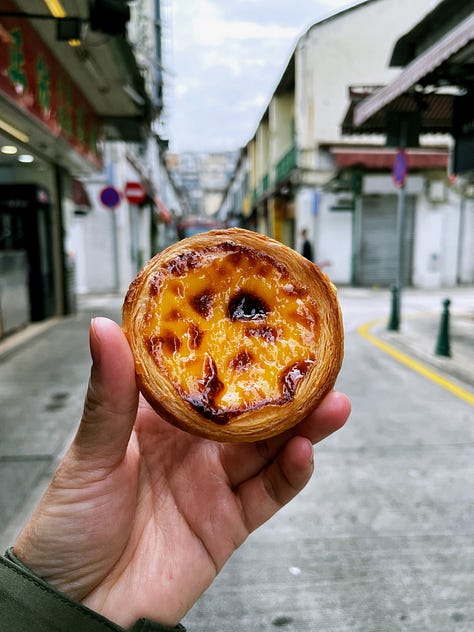
Representative dishes:
Tamarind Pork (罗望子猪肉). Left. An example of Macau’s Southeast Asian influences, this dish consists of pork stewed in tamarind juice and shrimp paste.
Macanese Stir Fried Rice Noodles (西洋炒米粉). Center. An example of a dish hewing closer to the Cantonese cooking system, this rice noodle is fried with cabbage, sausage, and shiitake mushrooms.
Macanese Egg Tart (葡挞). Right. An obviously quite Portuguese dish that has since become an icon in Macau and Hong Kong. Perhaps amusingly, the original egg tart maker in Macau sold their recipe to KFC when they entered the Chinese market, so KFC is perhaps ironically a reasonably good spot to enjoy the snack (so long as you’re able to get them when they’re hot and fresh).
Hong Kong Teochew
For too long, I thought about Teochew food in the framework of “Chaozhou-Out”. Teochew people originally came from the estuary of the Han River in eastern Guangdong, after all, so if you want the ‘original’ or ‘authentic’ Teochew food, that’s where you’re going to find it.
Let me give an example of why that’s wrong. One of the dishes most synonymous with Teochew food these days is Beef Hotpot (center, below) — mild pot of broth, premium cuts of beef, chili-garlic based dipping sauce. Tasty concept that seems to be replicated anywhere in China - or the world - where you can get quality beef.
The thing’s iconic, and totally did not originate from Chaozhou. It came from Teochew people in Hong Kong.



These days, I think of Teochew cuisine in a similar sense as the Portuguese Lusophone world. That is, not in the simple terms of Chaozhou-Out, but rather that all of the major nodes in the Teochew trading network — Chaozhou, Hong Kong, Vietnam, Singapore, and Bangkok - are all part of a larger ‘system’.
Teochew chefs tend to delineate three schools of Teochew cuisine: Chaozhou, Hong Kong, and Southeast Asian. Seems to be as reasonable of a starting point as any.
Now, I’m not a believer in ranking cuisines. But I do feel a bit compelled to say that I personally enjoy Hong Kong Teochew the most. Of the three, Hong Kong Teochew cuisine conforms most to how Cantonese would define quality standards, and I’ve vigorously and enthusiastically internalized Cantonese culinary propaganda for over a decade now.
Regardless, Hong Kong is undeniably a good place to eat Teochew food.
Representative dishes:
Fishball noodles (鱼蛋粉). Left. The infamous Kowloon Walled City, once a quite working class Teochew neighborhood, used to be a center of Hong Kong’s fishball production. Today, there are Teochew fishball noodle joints scattered across Hong Kong — served with Teochew style rice noodles, and a spicy chili oil now known in the west as “Chiu Chow Chili Oil” (in Hong Kong, it’s usually just called ‘Hong Kong chili oil’, as the ingredient is not traditional to the Chaozhou mainland).
‘Wet fried’ beef noodles (湿炒牛河). Right. In contrast to the Cantonese ‘dry’ fried beef rice noodles, this Teochew sort smothers theirs with gravy (as the cuisine has a penchant to do).
Taiwan
Why do I tend to sound so weird when I write about Taiwan?
Let me be frank. Discussing food in Taiwan is difficult for us, for two major reasons.
First, whenever I write about the island, words need to be selected carefully. Whenever I include a map of China that includes anything off the west of Fujian, the map needs to be selected carefully. We live in China, not America. Our livelihood is in China, Steph’s family is in China, and we enjoy all of those things being in China. We simply cannot be fast and loose with our words, mindlessly employing the sort of verbiage that would be second nature to many Americans3.
The second reason Taiwan is difficult is because of travel. Our culinary opinions are forged by… actually going places. You can read all you like, you can cook all you like, but you can’t truly understand what a cuisine is really like until you get your feet down in the soil of a place.
Like most mainland Chinese, Steph - the real brains of this channel - is currently barred from independent travel to Taiwan. On the Taiwan side, in the pre-Trump era they really liked to discriminate based on which mainland city you came from (i.e. which Hukou you held), and Steph’s was never on the approved list. And of course, as relations deteriorated, the mainland pulled their economic carrot of ‘mass tourism’ away, as something they could keep in their back pocket.
I, Chris, have been to Taiwan (briefly) twice - both a long time ago, before we started the channel. We are certainly not the best people out there to talk about food in Taiwan.
And yet, with those caveats, when I look at English-language food writing on Taiwan, a lot of it feels to be the perspective of… I dunno, Los Angeles gazing westward: “I flew into TPE and ate these things on my holiday”. I think we can provide a different perspective — from the mainland gazing eastward, i.e. how we think about the food there in the context of the food that we know.
Certainly, Taiwanese people themselves would have the most nuanced and valuable view of all the three groups.4
Fujian-Derived Taiwanese
A little like the city of Hong Kong within the Cantonese culinary universe, you simply cannot talk about Taiwan without talking about Fujian. Whatever outside influences are there — and there’s certainly plenty, given the island’s unique history — Fujianese food is the base. It’s the foundational system, the core assumption:
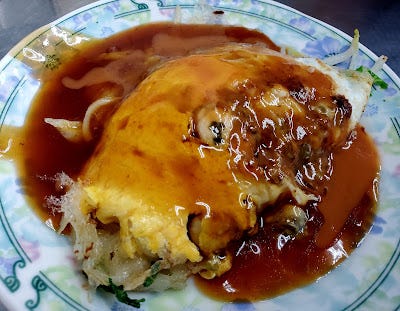


Taiwan-style Oyster Omelette (蚵仔煎). Similar in general approach to the Fujian style of the dish (i.e., heavy on sweet potato starch), the Taiwanese sort often includes egg in the mix and, of course, smothers it all in a sweet and savory gravy.
Oyster Mianxian (蚵仔面线糊). With some broad conceptual similarities to mianxianhu in Minnan, Taiwan Oyster Mianxian uses larger rice noodles, thickens with starch, and features oyster in place of a mix of seafood.
Squid Geng (花枝羹). Perhaps related to the Quanzhou beef classic, Taiwanese Squid Geng makes use of flash fried squid and thickens with starch.
I mean like… Oyster omelettes. Thick soups. Thick vermicelli soups. If these don’t sound familiar, definitely go back and re-read the section on Minnan food.
The reason for this is because a majority of the island’s inhabitants are descended from either Hoklo (South Fujian/Minnan) or Fujianese Hakka that migrated to Taiwan over the course of the Qing dynasty and the Japanese occupation. This group has historically been referred to as the Benshengren, or ‘Province Natives’ (not to be confused with Taiwan aboriginals).
If you were a lumper, there could be a case to be made that this sort of Taiwanese fare could perhaps be grouped in with Minnan. But these dishes do very have different Taiwanese versions, and in any event, it’s a moot point. Post-war, the Fujianese base was then layered on with another coating — the waishengren.
Non-Fujianese Taiwanese
As the nationalist forces retreated to Taiwan in the waning days of the civil war, many of them fled to the island along with, well, as much of their family as they could. And while the former Japanese colonial military bases could, by and large, house the ROC military personnel themselves, supplemental housing had to be built for their dependents.
The villages that sprung up from this ended up being labeled 'juan cun' (眷村) or ‘military dependents villages’. And because these dependents could and did come from pretty much anywhere, the food whipped up there ended up being this mishmash of stuff from all across the country – stuff like xiaolongbao, heyebing, and beef noodle soup.
As the years passed, those dishes ended up changing and morphing to their local environment (as foods tend to do), over time collectively being referred to as 'juancun liaoli' (眷村料理) or the cuisine of the military dependents villages.



Guabao (刈包). Left. In the mainland this sort of split ‘bao bun’ is called heyebing (荷叶饼) that can be found from Fujian to the north. A street food classic in Taipei, it’s classically stuffed with red braised pork, fermented mustard greens, and (ideally) cilantro and pounded peanuts.
Taiwan-style Beef Noodle Soup (台式牛肉面). Center. A heavily, heavily localized version of Sichuan Red Braised Beef noodle soup. There are many variants dotted throughout the island (some hewing closer to the Sichuan sort than others), but an undeniably Taiwan specialty is to top the soup with fermented mustard greens.
Taiwan-style Hot and Sour Soup (台式酸辣汤). Right. Another dish with many varieties across Taiwan. Somewhat similar to the Wuxi style of the dish, the soup is undoubtably quite localized today (the addition of carrot is rather notable).
This naming convention, however, could perhaps best be thought of as a nostalgic callback. These days, the food at large in Taiwan has undeniably become a bit on an amalgam — whether it’s a blend, ala Beijing, or a chunky stew (like Huaiyang and Tucai in Jiangsu) could perhaps be a matter of debate.
There are likely cleavages that could be made geographically. The South, around Tainan and Kaohsiung, appears quite a bit closer to Fujianese food than the more layered fare of the North. But an accurate mapping would require, well, people that actually have the legal ability to travel to the island.
Southeast Asia
Southeast Asian Teochew
You can find Teochew food in Singapore and, historically at least, South Vietnam (after Saigon fell, a non-insignificant number of Vietnamese refugees to America were actually Teochew — mercantile families generally don’t fare too well under communism, after all). Unfortunately, I’m not overly educated about what the Teochew food looks like in those areas, but I can definitely discuss Thailand.
People tend to underrate the Bangkok-Chaozhou connection. After all, the very founder of the Kingdom of Siam — Taksin the Great — was Teochew. Teochew were historically heavily integrated with the Thai royal court, they staffed the bureaucracy and functioned as tax collectors. As the centuries wore on, they began to form the backbone of the country’s urban class and petit bourgeoisie.
We discussed the whole story in an old video of ours, but the TL;DR is that in the early 20th century, in the face of a rising pan-Chinese nationalism, the Thai state forcibly assimilated the Teochew into a Thai identity (as well as the Lao and the other Chinese dialect groups). And say what you will about forced assimilation — it’s undeniably an ugly process — in a generation or two, everybody… forgets.
So where “Thai-Chinese” begins and ends is really quite difficult to parse. Where do we put the backpacker favorite of Mee Krob? It was invented by a Teochew family in Bangkok! Or maybe the case of Shrimp Tom Yam (i.e. the chili jam and milk sort that tends to be synonymous with ‘Tom Yam’ internationally) — this variant was apocryphally borne from a Chinese restaurant in Sam Yan.
That said, if you go to Bangkok’s Chinatown, you can also find food that’s explicitly Thai-Chinese — this is generally the sort of fare that we would be confident to list under ‘Southeast Asian Teochew’, but definitely do know that a wider definition could blow this category wide open:



Representative dishes:
Chinese Olive and Pork Fried Rice (ข้าวผัดหนำเลี๊ยบหมูสับ/乌榄肉碎炒饭). A dish that features that ever-so-Teochew ingredient of brined Chinese olive (หนำเลี๊ยบ/乌榄). Chinese olive minced together with minced pork is a classic Thai-Chinese stir-fry, and is often used as a base for fried rice as well. Pictured is a fried rice topped with cashews and chilis.
Five ‘Fruits’ (ผัดโหงวก๊วย/炒五果). Originally an old school Teochew festival dish consisting of nuts and fruit — historically would be seen in three, five, and seven ‘fruit’ versions in Chaozhou. Three musts are ginko, cashew, and miju date. Pictured is a version served with ham, dried persimmon, shrimp, water chestnut and deep fried basil (a Thai Teochew classic).
Goose foot noodles (ขาห่านอบบะหมี่/鹅掌面). Another old school Teochew dish that’s lived a second life in Southeast Asia. This pot consists of stewed goose feet cooked in rendered pork fat, mixed with noodles and 'baked' (cooked over a stove in a covered dry pot).
Straits Chinese
There were three major Chinese merchant powers in Southeast Asia: the Hokkien (south Fujianese), the Teochew, and the Cantonese. A bit like the English, the Spanish, and the French in their overseas adventures… these settler-mercantile groups were fundamentally rivals. Whether it be the kingdom of Siam or the various Malay Sultanates, they frequently duked it out over influence and trading rights within these polities. The Hainanese and the Hakka, meanwhile, would often be imported by these groups as laborers, forming the five major dialect groups within Southeast Asia.
In some places, certain dialect groups maintained dominance. Siam was dominated by the Teochew; Borneo, the Hakka.
The Straits - Singapore, Malaysia, and Sumatran Indonesia - was an area where all five dialect groups existed alongside of eachother. A bit like Teochew and Central Thailand, it can sometimes be quite difficult to determine where ‘Straits Chinese’ ends and begins. Should Peranakan Cuisine be considered as part of Straits Chinese?
I’m certain someone more familiar with the cuisine down there would be able to make some more thoughtful and educated delineations. But it feels a crime not to mention the Straits in a list of Chinese cuisines, given just how globally iconic some of these dishes are.






Char Kway Teow (炒粿条). Top left. ‘Kway Teow’ being Teochew for ‘rice noodle’, this dish literally just means ‘fried rice noodle’… and as such you can find variants all across the Straits. Pictured is a classic sort stir fried with black sweet sauce, an ingredient that sort of hits the midpoint between soy sauce and molasses.
Niang Tofu (酿豆腐). Top center. Originally coming from the Hakka Stuffed Tofu above — in Southeast Asia it began to become a whole different beast, with all the Hakka-Stuffed-Stuff served in a singular stall. While seeing it clear soup is the most classic, pictured is a stall in Kuala Lumpur which serves their in Laksa.
Hainan Chicken Rice (海南鸡饭). Top right. Obviously quite inspired by the Hainan dish that imparts its name, the Southeast Asian versions introduce a number of twists. In particular, the dips often feature stronger flavors such as black sweet sauce (⿊甜油), chili, and Calamansi lime. If only it had the same chicken quality as the Hainan version…
Popiah (润饼). Bottom left. Soft, fresh spring pancakes wrapped around vegetables. Derived from the Hokkien take on the concept, you can find these pancakes dotted around Southeast Asia (called ‘Lumpia’ in Indonesia). This one contains bean sprout, jicama, carrots and egg.
Bak Kut Teh (肉骨茶). Bottom center. An iconic pork bone soup seasoned with spices — particularly garlic and white pepper. Just like most of the items on this list, regional differences abound (the Singapore variant is the most white pepper heavy)
Fujian Noodles (福建面). Bottom right. ‘Fujian noodles’ can mean many different things depending where you are in the straits (thankfully, Straits people seem well represented on English language Wikipedia, where there’s a helpful table on the subject). Pictured is the Singapore version, whereby egg noodles are mixed and cooked in a rich seafood sauce.
Other Candidates Outside of Mainland China



But then… what of American-Chinese takeout? Indian-Chinese? Japanese Chuka? Peruvian Chifa? Chinese cuisine has certainly made its way throughout the world!
And obviously, many of these global inventions are incredibly distinct. If we just zero in on takeout Chinese menus in the United States, the Crab Rangoon, General Tso’s Chicken and Pupu Platters certainly do not exist in restaurant menus on the China mainland. I’ve seen a lot of people call this stuff “Chinese American Cuisine”, and maybe we should just swim with the current, go there too and add another tally mark to our list of Chinese cuisines.
But something that nags on me is that from what I’ve seen, these dishes usually seem to be relegated to a commercialized context - what Chinese American families cook at home for themselves is seems to be quite different.
Now, I don’t live in America, so definitely do correct me if I’m wrong. My sample size is incredibly small (a couple friends from uni and that’s about it). At home, my friend whose family immigrated from Guangdong, they ate… Cantonese food. My buddy that came from a Teochew family in Vietnam, they ate… Teochew Vietnamese food. When me and Steph go back to the USA to see my family, we’ll sometimes go and shoot a little B-roll at my old local takeout joint - over the years, we’ve started chit chatting with the owners (they’re from Fuzhou). Even in the face of Steph’s compliments, sometimes they’re sometimes a little puzzled why we’re eating at the takeout joint, and recommend other more authentic Chinese restaurants in the area.
At home, it doesn’t seem to me like Chinese-Americans whip up Pupu platters any more than the rest of the country – if anything, maybe a little less.
It’s a commercialized cuisine.
Now, to my mind, that doesn’t make it bad – I’m no authenticity snob, I like this stuff – but it does make it incomplete. The way I think about it is that a cuisine should be practiced both in restaurants and in homes, otherwise it’s really hard to draw the line between ‘cuisine’ and ‘restaurant concept’. Like, is “Peking Duck” or “Sichuan Hotpot” a cuisine? Those restaurants usually have their own spate of dishes! Or maybe more relevant here… what about Cha Chaan Teng, Canto-western fusion?
As we said before… for our map, we ended up deciding that Canto-western wasn’t a ‘cuisine’: it was an element of a cuisine that defined what it meant to eat Hong Kong food.
In the same way, Chinese takeout is one of those fundamental restaurant concepts like the the Diner, the Deli, and the Pizza Joint that really forged a larger ‘American’ cuisine. At this point, Sweet and Sour Pork quite obviously belongs to that pantheon of Americana - right alongside barbecue, pizza, subs, and burgers.
It’s a similar thing happening with Japan. Could you imagine Japanese cuisine without Chuka dishes? Seriously, just peruse the Wikipedia entry on the subject. This wouldn’t just be a Japanese cuisine without the usual suspects like Mabo Dofu and Chashu - it would be a Japanese cuisine without Ramen. The thought would be borderline unthinkable.
You can, of course, disagree… I keep flipping back and forth myself.
Some definitions of ‘Dong River Hakka’ extend east and include all of Guangdong - Meizhou included (separating out Jiangxi and Fujian Hakka into a separate Hakka cuisine). This definition felt a bit off to us - in our thinking, logic would dictate that Dong River Hakka would center around, well, the Dong River. A convincing geographic argument could be made that the city of Heyuan should be included in as Dong River Hakka, as… it’s a Hakka city that sits on the Dong River. To us, the food felt more similar to Meizhou than it did Huizhou, but we’re also not experts.
For example, classic works include 梦粱录, 随园食单, 中馈录, etc.
Of course, when I say these things… your mind may immediately jump to some sort of Orwellian fantasy, but that’s not how any of this works. Put simply, cancel culture exists in China, but it’s performed by the nationalist right. Transgressions are forgiven if apologies are immediate and full throated (see: Nigel Ng). If you’re unwilling, harassment can follow. Doxxing can follow. If you incorrectly use an ‘all claims hashmarked’ map from Wikipedia, the government itself doesn’t really care - but they also aren’t exactly in a hurry to shield you from private consequence.
Our personal political perspective on the topic is nuanced, and will be kept private.
We were a bit shaky on how and whether to split Taiwan into the component cuisines. On our map we counted it as one, with a callout to Hoklo (Taiwanese Minnan) and Military Dependents Villages (Post war mainland). Someone with more experience in Taiwan would likely need to complete the square there.

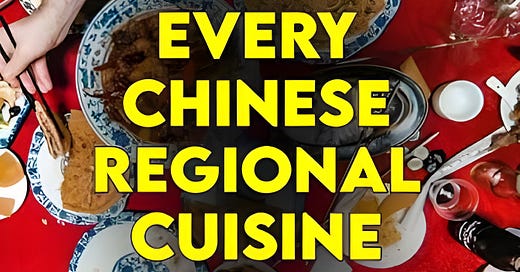






Singaporean here, with some comments on the Straits Chinese portion...
On the lumpia - the pictured variety would probably be more commonly referred to as popiah instead (given its provenance from a Singaporean hawker center), and the primary ingredient for the filling is shredded stewed jicama (known locally as bang kwang). I can't say for sure, but I doubt that variety of popiah would have any glass noodles either.
On Straits Hainanese chicken rice - in practice I don't see a lot of local hawkers adding pandan leaves to the rice when cooking. Also an important difference between the Singaporean and Hainanese varieties is probably the nature of the stock* - in Hainan, they might use pork broth, whereas in Singapore this is rarely done. Though I profess ignorance on other regional styles.
*https://www.nlb.gov.sg/main/article-detail?cmsuuid=ceddd346-4072-4981-b20d-f771bea7dd81#:~:text=One%20difference%20between%20the%20Hainanese,of%20the%20Hainanese%20chicken%20rice.
The picture you've chosen to depict a niang tofu dish appears to actually be for a curry laksa dish from a KL stall**, which I wouldn't have thought would have included niang tofu (it looks like green beans, tofu skin, and eggplant). This is entirely subjective (and biased towards Singaporean foodways), of course, but I do agree with you that a more representative example of a niang tofu dish, to my mind, is a clear soup^. That said, it is indeed quite common for yong tau foo stalls to offer a laksa-based soup too.
**https://www.facebook.com/photo/?fbid=549422163893129&set=pcb.549422247226454/https://maps.app.goo.gl/q3sYroa6iREshQ1U6
^https://en.wikipedia.org/wiki/Yong_tau_foo
Just some pedantic nitpicking, but I do love and appreciate what you're trying to do here, so offering some suggested amendments in the most constructive spirit!
Per Enshi and Tujia.... The fundamental central dish is He Zha, a soupy tofu that's spiced and mixed with mustard greens. Accompanying are a dozen or more small plates that are like the Tujia version of Tapas...peanuts, 1000 year preserved egg, pig ear (a root salad), quan ya (spring time shoot off a specific tree) and a bunch of other stuff i don't feel like typing with my thumbs. if you're interested, I can flesh this out quite a bit. It really is unique due to its previously isolated and remote status.